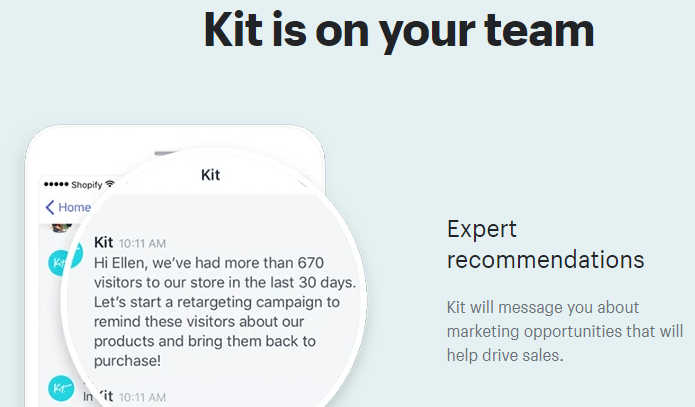How to Choose The Right Email Marketing Agency
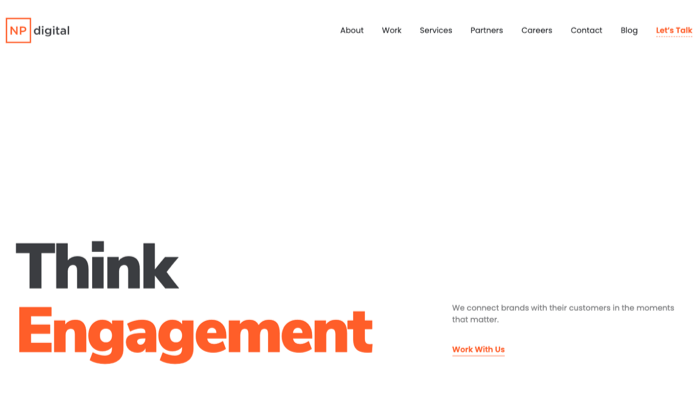
Nothing converts like email.
Email beats all other marketing channels and can generate $37 for every $1 you invest.
Even though email marketing can generate a ton of revenue, it’s still not easy.
You need to know which email tools are best, how to use them so you don’t end up in spam folders, and how to create emails that convert.
Even for fully-staffed marketing teams, it can be overwhelming.
Email marketing agencies are perfect for overcoming these challenges.
They know how to use the tools and run fully-scaled email campaigns. They can also distill your brand and offer into great campaigns that generate revenue.
Today, I’ll walk you through how to choose an email marketing agency that’ll help you unlock all the business value email holds.
Good?
Well, let’s start from the basics.
Know Your Goals and Desired Outcomes
Before you jump straight to the top email marketing companies and pick one to work with, it’s a good idea to pause first.
Why?
You’ll get much better results.
Famous email agencies, like the ones I’ll recommend, usually have a track record of overseeing successful email marketing strategies and campaigns.
However, it’s never a one-size-fits-all situation.
Some agencies only excel when working on specific projects or campaigns. Others drive better results when working with specific kinds of businesses.
Knowing your goals and desired outcomes with email marketing gives you the right lens to evaluate different agencies and know which one is best for your needs.
Not to mention, it’ll help your agency get started a lot faster. The clearer the goal, the better the outcome.
Let’s take a look at some examples.
Example #1: Build and grow your email list
Without an email list, you can’t do email marketing.
And if you have a small list of, say, 33 email addresses, you’ll never get the full benefits of email marketing either.
The first step is to build your email list.
You’ll achieve this by choosing an agency with experience executing list-building campaigns to get your first 100, 1,000, or 10,000 email subscribers.
Take yourself, for example.
You won’t give a company your email address for nothing, right?
Absolutely not! We all get enough spam as it is.
Similarly, most people would only subscribe to your email list in exchange for something valuable.
In the digital marketing world, this could be an ebook, a checklist, or other forms of relevant content promoted to the audience whose emails you’re targeting. Consider choosing an email marketing agency with experience creating and promoting amazing content. The better the content, the faster your list will grow.
Example #2: Increase your email open and click-through rates
Low open and click-through rates will destroy your list.
If your open and click-through rates are low, you’ll run into a cascading series of problems:
- Your audience isn’t seeing your offers. That’s less revenue.
- Email service providers like Gmail, Outlook, and Yahoo will notice your low performance. Then they’ll flag you as spam or stop delivering your email altogether.
- Now your open and click rates get even worse.
- Even if you improve your campaigns later, they won’t deliver nearly the same results.
- Improving your email reputation is REALLY hard.
Instead of risking this email cycle of doom, it’s a good idea to partner with an agency that knows what they’re doing.
They can look for early signs that something’s wrong, course-correct early, and keep your email reputation safe.
In this case, look for an email marketing agency that is exceptional at developing strategies and tactics to help increase your open and click-through rates.
The two examples above were to show that your goals and desired outcome with email marketing go a long way in determining what agency to choose.
They were also to demonstrate that no agency is a one-size-fits-all for all email marketing problems.
Set your goals first, then look for an agency that specializes in those goals.
6 Characteristics That Make a Great Email Marketing Agency
There are hundreds of email agencies out there. Maybe thousands.
And if you visit the websites of these agencies, every single one claims to be the best.
But what characteristics make an email marketing company great? And how can you vet and choose an agency to work with?
1. Great Content Creation
Think of all the emails you receive from other companies.
Do you know why you can’t wait to open and engage with some, but would ignore, delete, or unsubscribe from others right off the bat?
In most cases, it’s because you don’t value the content of those emails.
Amazing content keeps people opening and reading. Then when you send an offer, they’re willing to consider it.
Great content is the core of any serious email strategy.
Check to see if they focus on a process for crafting engaging email content. The best ones always do.
2. An Impressive Client Portfolio
Excellent email marketing agencies didn’t achieve that status overnight.
They worked with dozens or hundreds of brands to execute successful email campaigns.
Because of this, they should have plenty of top-tier brands in their portfolio. And case studies that show you exactly what was done.
Not all of this can be shared publicly. But when you’re exploring options with agencies, ask for examples during your initial calls. The agency should have plenty of examples to point to. If they struggle to come up with some, look elsewhere.
It’s a great way to quickly vet agencies of all types.
3. Thought Leadership
Exceptional email marketing agencies are always on top of email trends. It’s constantly evolving and you don’t want to work with someone that’s using tactics from 5 years ago.
An easy way to check for this is the agency’s blog, YouTube channel, or their own email list. Within 20-30 minutes of consuming their content, you should learn a ton. And it should all be cutting edge.
That’s a good sign they’ll be able to apply those same tactics to your email campaigns.
4. Deep Expertise with Email Tools
Great agencies will have used them all.
If you ask them which tools are best, you’ll quickly learn:
- Which are most popular
- Strengths and weaknesses of each
- The handful of tools to avoid
But don’t worry about which tool they recommend. Pay attention to their depth of knowledge when speaking with them. They’ll probably start by recommending a single tool. Then as soon as you ask any follow up questions, they should have plenty of qualifications, nuance, and detail to their answers.
You should get the feeling that the agency knows this stuff cold. If not, find someone that does.
5. Has Specific Rules to Avoid Spam
If you’ve been hit hard by spam flags, you might need an agency that specializes exclusively on reviving domains with negative email reputations.
Most of us don’t need to go that far.
But you absolutely want to work with an agency that knows how to stay out of the spam box.
Also ask new agencies about how they stay out of spam, their processes to keep things clean, and early warnings that they like to look for.
You should be blown away with the thoroughness of their answers.
If not, keep looking.
6. A Great Company Culture
By choosing an email marketing agency to work with, you’re entering a business relationship with another business entity.
So, before you proceed, check that their company culture fits with yours.
Without a good fit on culture, you’re going to get email campaigns that don’t jive with your brand. You could anger your audience and turn them away. Or play things too safe and leave money on the table.
There’s no right answer on culture, just make sure their culture and yours fit well.
Ask for samples of recent campaigns that they’ve done. They’re likely to do similar work for you.
How to Work With an Email Marketing Agency
Working with an exceptional email marketing agency isn’t like dashing into a grocery store, filling your cart, and dashing out in a few minutes.
There are steps you’ll need to take that ensure your partnership with one leads to business growth via email marketing.
1. Align your in-house team
Most email marketing agencies won’t work in isolation but as an extension of your in-house digital marketing team.
Hence, to ensure a smooth partnership between you and them, you should:
- Have meetings with stakeholders in your company to align relevant teams on the need to work with an email agency.
- Communicate how the agency’s work would impact your business and why it is necessary.
- As needed, appoint employees to work directly with the email marketing agency.
Doing this ensures team alignment between the agency and your company. Also, it keeps the agency in sync with your values, company culture, and the goals for choosing to work with them.
2. Discovery session
As you first go out to contact an email marketing agency, they won’t jump straight into sending you a proposal or contract.
The best email marketing agencies act like doctors who only prescribe after they diagnose.
And to start diagnosing your challenges and goals with email marketing, expect to fill an inquiry form, followed by a discovery session.
3. Research & strategic recommendations
Before making a specific proposal, any good email marketing agency will do an extensive round of research on your current campaigns. This will include things like:
- Signing up for your lists and looking at your current campaigns
- Mapping out your signup flows
- Checking landing pages and signup offers
- Looking through social profiles and email funnels from other channels
Once they have a complete picture of where you are today, they’ll be able to put a proposal together.
4. A working contract with project deliverables
A typical work duration with an email marketing agency spans several months.
To take on that kind of scope,agencies usually prefer to send a formal proposal and contract for you to sign.
Take your time and this stage and go through the proposal in detail. You should feel great about every piece. If you have any concerns, work through them now. It’s really easy to change scope, budget, or goals now.
Once you fee good about it, get the contract signed.
5. Onboarding
Expect an onboarding process customized for your team after you sign the contract.
During this step, the agency will usually ask for all your internal document and tool access. Expert to send them invites for your Google Analytics and email tools. Also put together every piece of internal documentation that you have on your email campaigns. The more info they have, the better.
From here, the agency will get started on the work and should have regular check-in calls along the way.
How to Find The Right Email Marketing Agency For You
To choose an email marketing agency that’s right for your needs, the steps I recommend are:
- Be sure about your business goals and desired outcomes from email marketing.
- Consider agencies with the characteristics above.
- Choose an agency with expertise in the area you need help with. And where possible, also prioritize those that have worked with reputable brands.
- Finally, know that email is part of your digital, and by extension, content marketing strategy. Hence, it’s best to choose a company with bandwidth for those.
To help, we reviewed hundreds of agencies and found these to be the best.
The 5 Top Email Marketing Agencies
#1 Neil Patel Digital – Best For Email Content
Every time you send an email, people unsubscribe.
That hurts the long-term prospects of your email list.
Since every email has a real cost and makes your list smaller, it’s best to make them count.
The best way to do this is with great content. Your unsubscribes will be lower, your list will be more engaged, and you’ll generate more revenue in the long-run.
Content, including email content, is one of the core areas of expertise at my agency, Neil Patel Digital.

#2. InboxArmy – Best for Full-service Email Management
InboxArmy comes highly recommended, as a full-service email marketing and management company.
This agency’s services include email strategy development, template design, email automation, and other.
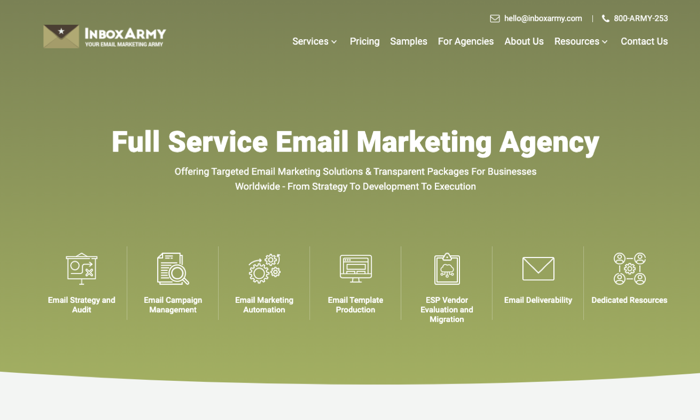
InboxArmyserves companies such as Airbnb, LandCentral, and Jockey. If you’re looking for serious email pros for your B2C company, I’d reach out to them.
#3 Fix My Churn – Best for SaaS Onboarding Emails and churn
Fix My Churn works with SaaS companies.
User onboarding emails are a very unique skill set. The content, CTAs, sending logic and tools are completely different. If you want to improve your SaaS emails, you really need experts in this area.
Fix My Churn applies top-level SaaS copywriting skills to create email onboarding and churn-eliminating sequences to turn free and trial users into happy, long-term customers.
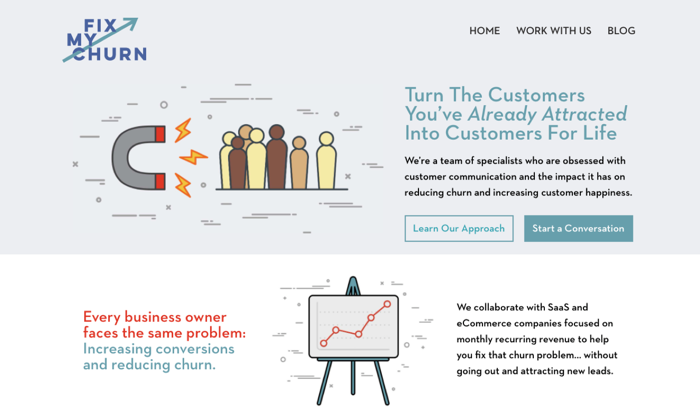
Led by its Founder and SaaS email expert, Val Geisler, Fix My Churn has earned a reputation as an email marketing agency for SaaS companies like Buffer, Aweber, Podia, InVision, and others.
I’d also consider them if your have any type of subscription offer.
#4 Action Rocket – Best for Enterprise Email
Action Rocket needs no introduction as an email marketing agency for enterprise companies.
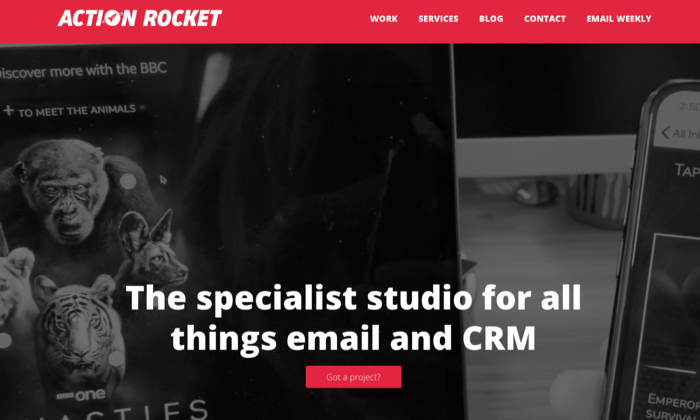
This agency even works with leading email software companies like Campaign Monitor, MailChimp, Litmus, and others to shape the email marketing space.
Using its vast years of experience, Action Rocket strategizes and develops custom email and CRM programs for enterprise companies, including Marks & Spencer, the BBC, and others.
If you want serious muscle behind your email strategy, reach out to them.
#5 SmartMail – Best for Ecommerce Email
SmarMail is our recommended email marketing agency for ecommerce businesses.
Every business model has its own unique challenges with email and ecommerce is no exception.
You need cart abandonment emails, promotional emails, lifescycle emails for repurchases, and receipts with guaranteed email deliverability.
This agency excels at helping online stores acquire, convert, and retain customers by strategizing and launching email marketing campaigns based on automated triggers across buyers’ lifetime cycle:
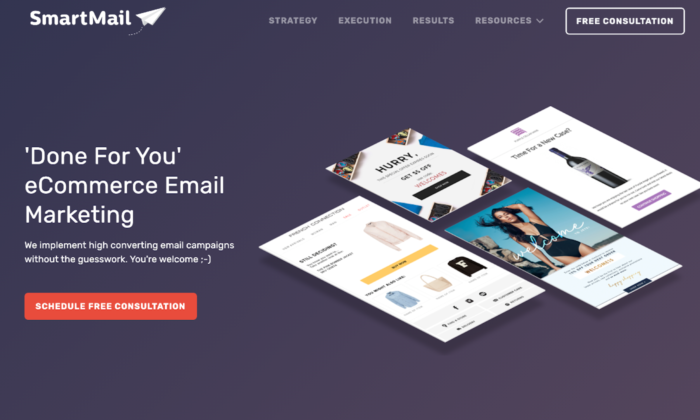
SmartMail has an excellent track record, helping ecommerce companies generate about $187 million in revenues. Their clients include French Connection, Skechers, and others.
Get Email Right to Drive Growth
Email marketing isn’t going anytime soon. It is here to stay.
And it generates a ton of cash. Choosing the right agency will get you that growth a lot sooner.
Set your goals, then start looking for the right agency for you.
Even if you plan on doing email inhouse, the right agency can get everything set up correctly from the beginning. That will save your team a ton of time and prevent disastrous mistakes like getting all your emails stuck in the spam folder.
The post How to Choose The Right Email Marketing Agency appeared first on Neil Patel.
How to Hire SEO Freelancers

Ranking a website or web page today is not as easy as it was a couple of years ago.
Not only is the competition stiffer, but the constant changes in the algorithms that determine rankings also make it more challenging to stay on top of your SEO game.
As a business owner, keeping up with all these changes and regularly updating your website is something you might not have time for.
That’s why you may need to enlist the help of an SEO freelancer.
How an SEO Freelancer Can Help Your Business
Before we go any further, let’s quickly define what a freelance SEO is.
Simply put, an SEO freelancer is a professional who helps you gain more visibility on search engines. If you hire the right one, they can get you to rank for your main keywords, thereby helping you drive tons of traffic to your website and business.
So how can an SEO freelancer help your business?
Keyword Research
One of the foundational principles of SEO is keyword research.
This is the practice of discovering search terms that users enter in search engines when they want to find something. Discovering the keywords used to search for your products or services is crucial to boosting your SEO.
This foundational practice is one of the ways an SEO freelancer can help your business rank well.
Content Strategy
Content strategy involves planning the entire process necessary to create content. It includes, among other disciplines:
- Keyword research
- Understanding user intent
- Crafting optimized headlines
- Creating content outlines
- Determining content types
- Choosing the best platforms on which to publish the content
Developing a content strategy is key to helping your content rank well, especially in a space saturated with content on similar topics.
Content Creation
Another integral part of SEO is content creation.
Creating SEO content is a science that not many people understand.
It requires knowledge of proper keyword placement, structuring and formatting content properly, and writing in your audience’s preferred tone, among other things.
While anyone can be a good writer, not everyone can be a great SEO writer.
Again, this is one of the few ways an SEO freelancer can help drive your business forward.
Link Building
Besides content, another critical aspect of SEO is link building. This is because search engines use links to gauge the authority of content and websites. The more authoritative a web page is, the higher search engines rank it for queries related to your keywords.
A successful strategy involves building relevant links on three levels:
- Internal links: These are links between content on your website and must be chosen strategically.
- Outgoing links: Links to other sites are important, but if done incorrectly, you could link to competitors, low-authority sites, or even spammy websites.
- Inbound links: Also called backlinks, these point to your website, and search engines deem them votes of confidence in your website. Quality, not quantity, is the key here.
Good SEO freelancers also know the importance of monitoring your backlink profile. This is important because toxic backlinks could negatively impact your SEO.
Link building is a time-consuming endeavor that requires knowledge of the right kind of links to build and strategies that work.
To build links that will help your website rank better, you must get a professional to do, which is an instance where an SEO freelancer will come in handy.
As long as you want to make an impact online (of which you have no choice), you must invest in SEO. That’s why you must consider hiring an SEO freelancer.
How to Hire the Best SEO Freelancer
Hiring a good SEO freelancer can be a tricky business.
For one, most SEOs are self-taught, and typically the only way to verify their knowledge or experience is through their portfolio.
Secondly, the world of SEO is constantly changing and knowing which SEO freelancers keep their knowledge and skills relevant is almost impossible.
So how can you improve your chances of hiring the best SEO freelancer?
Here are a few simple tips:
Determine Your SEO Needs
The first step to finding the right SEO freelancer for you is to determine your exact SEO needs.
If you’re not sure how to do this, you may need to look for an SEO freelancer that has experience in conducting SEO audits. Of course, in most cases, this is an add-on service, so expect to pay for it separately.
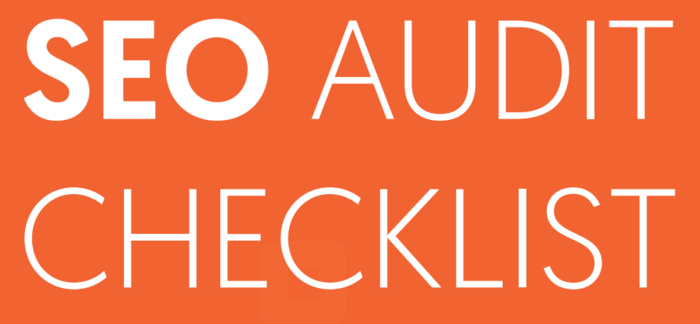
However, if you want to do it yourself, check out my SEO checklist for direction.
Determining your SEO needs makes it easier for you to know what to look for in an SEO freelancer.
Features to Look For in an SEO Freelancer
Now that you’ve determined your SEO needs, the next step to hiring the best SEO freelancer is to know what to look for in one. Here are a few pointers:
Check their Track Record
Every SEO freelancer worth their salt has a track record that proves their knowledge and skill.
To be worth your consideration, they must have results to show their effectiveness in delivering the services you want.
So how do you check their track record?
- Ask to see a portfolio of their work
- Visit their website
- Ask for references from past or current clients
- Read reviews on their website or other platforms
Checking an SEO freelancer’s track record is critical because you want to hire someone who knows what they’re doing. Failing to do so could lead you to spend money on an SEO freelancer that won’t get you the desired results.
Interview Your Prospective SEO Freelancers
Once you’ve narrowed down your list of potential candidates, it’s time to find the best SEO freelancer for your business.
To do this, you might want to conduct an interview to get to know them better.
Thankfully, with technology like video calling software, you can conduct interviews from anywhere in the world.
Get to know them, their methodology, and how they plan to help your business rank well.
Give Your Prospective SEO Freelancer a Test Project
Another strategy that will help you find the best SEO freelancer for your business is to give your prospective candidates a test project.
This will help you:
- Gauge their abilities
- Have insight into what your working relationship will be like
Your test must be based on the core duties you’re hiring your SEO freelancer for. This way, you’ll know exactly what to expect from them in terms of performance.
Know Where to Look for SEO Freelancers
Once you’ve determined your specific SEO needs, the next step to hiring an SEO freelancer is to know where to look for one.
Some of the best places to look include (but are not limited to):
Job Boards
Job boards are a great place to source SEO talent. A big advantage you get from the most popular ones is that they vet all freelancers in their database. That helps eliminate unsavory characters from the platform.
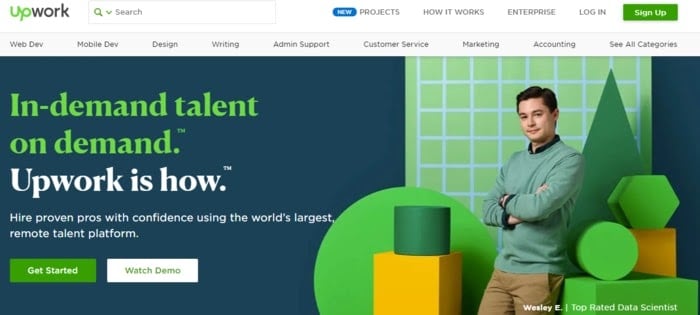
Some popular job boards you can get SEO freelancers on include:
- Indeed: Has a large pool of SEO freelancers. Searching through candidates using different filters makes it easy.
- Upwork: Arguably the most popular freelancer platform on the planet. Has a strict verification process.
- ProBlogger: One of the best platforms if you’re looking specifically for SEO writers.
- AngelList: Trusted by many startups for the high-quality talent pool. The best choice if you’re looking specifically for technical SEO freelancers.
- Fiverr: Great place to find affordable SEO freelancers, but you may have to sift through a lot of profiles to find the right person.
- Craigslist: Another great place to find good SEO talent. Unfortunately, however, you’ll have to do your own candidate vetting.
What if you want the freelancers to come to you? To source the best SEO freelance talent, you must know how to attract them, and you can do this by creating optimized job ads.
Hallmarks of an optimized job ad include:
- Keyword focused job description
- A killer headline
- Detailed but to the point
- Sells the benefits of working with your business
Once you’ve crafted your job ad and posted it, you’re sure to get a flood of responses from interested SEO freelancers.
Social Media
Social media is now playing a huge role in the recruitment process, helping businesses source top talent. If you’re looking for some of the best SEO freelancers, you’ll be sure to find them on social media platforms like:
Make sure to include a relevant hashtag (like #SEOfreelancers) when you post your need for an SEO freelancer.
Ask Google
Most SEO freelancers have websites to showcase their work, and if they practice what they preach, their websites should rank high on Google for their keywords (like SEO freelancer and other LSI keywords).
So if you’re looking for SEO freelancers, a casual Google search can help you discover professionals you can entrust your SEO tasks to.
If you want one who’s based in your locale, you can simply google “SEO freelancer+your area” to pull up results of the best local SEO freelancers near you.
When Not to Hire SEO Freelancers
As much as SEO freelancers have their advantages, there are times it wouldn’t be wise for you to go the freelancer route.
In those cases, you’re better off hiring an SEO agency.
Here are a few examples of such instances:
When Your Needs Exceed a Freelancer’s Capacity
Remember, SEO is a broad field. No one person can handle every SEO task you may need.
For example, if you want to execute a comprehensive on-page SEO campaign, you may require (among others):
- A content strategist
- An SEO writer
- An editor
True, you may be able to find an SEO freelancer who can wear all three hats, but if your content strategy is extensive, you may need at least one content strategist, one editor, and a couple of SEO writers.
In this case, you’re better off going the agency route.
Carefully evaluate your SEO needs and determine if the scope of work is manageable by one person or if an agency better handles it.
When You Need Different SEO Services
If you need different SEO services, you’re better off going the agency route.
This is because agencies have different skill sets in their human capital, and all your SEO needs can be taken care of under one roof.
It makes for a streamlined and cohesive SEO campaign.
Giving different tasks to different SEO freelancers could result in a disjointed campaign, and in some instances, what one SEO does could conflict with what another has done.
If Stability With a Team is Important
An agency has all the resources (human and technological) needed to execute projects quickly. Because of this, you’re also assured of quality work because they have quality controls in place.
Another advantage of an agency that many people overlook is the fact that if a freelancer gets sick or if life happens, your project could be put on hold indefinitely. With an agency, however, there’s rarely any downtime as they can easily find a replacement.
Conclusion
With many people opting to ditch the 9 to 5 and work as freelancers, you’ll have plenty of choices when it comes to picking SEO freelancers for your business.
However, there are two sides to this coin.
In your quest to find the best SEO freelancers, you may come across a few bad ones that may cost you your reputation, rankings, or resources.
That’s why you must know how to hire an SEO expert that will help you achieve your business goals.
Have you ever worked with an SEO freelancer before? If so, what was your experience with them?
The post How to Hire SEO Freelancers appeared first on Neil Patel.
How to Hire SEO Freelancers

Ranking a website or web page today is not as easy as it was a couple of years ago.
Not only is the competition stiffer, but the constant changes in the algorithms that determine rankings also make it more challenging to stay on top of your SEO game.
As a business owner, keeping up with all these changes and regularly updating your website is something you might not have time for.
That’s why you may need to enlist the help of an SEO freelancer.
How an SEO Freelancer Can Help Your Business
Before we go any further, let’s quickly define what a freelance SEO is.
Simply put, an SEO freelancer is a professional who helps you gain more visibility on search engines. If you hire the right one, they can get you to rank for your main keywords, thereby helping you drive tons of traffic to your website and business.
So how can an SEO freelancer help your business?
Keyword Research
One of the foundational principles of SEO is keyword research.
This is the practice of discovering search terms that users enter in search engines when they want to find something. Discovering the keywords used to search for your products or services is crucial to boosting your SEO.
This foundational practice is one of the ways an SEO freelancer can help your business rank well.
Content Strategy
Content strategy involves planning the entire process necessary to create content. It includes, among other disciplines:
- Keyword research
- Understanding user intent
- Crafting optimized headlines
- Creating content outlines
- Determining content types
- Choosing the best platforms on which to publish the content
Developing a content strategy is key to helping your content rank well, especially in a space saturated with content on similar topics.
Content Creation
Another integral part of SEO is content creation.
Creating SEO content is a science that not many people understand.
It requires knowledge of proper keyword placement, structuring and formatting content properly, and writing in your audience’s preferred tone, among other things.
While anyone can be a good writer, not everyone can be a great SEO writer.
Again, this is one of the few ways an SEO freelancer can help drive your business forward.
Link Building
Besides content, another critical aspect of SEO is link building. This is because search engines use links to gauge the authority of content and websites. The more authoritative a web page is, the higher search engines rank it for queries related to your keywords.
A successful strategy involves building relevant links on three levels:
- Internal links: These are links between content on your website and must be chosen strategically.
- Outgoing links: Links to other sites are important, but if done incorrectly, you could link to competitors, low-authority sites, or even spammy websites.
- Inbound links: Also called backlinks, these point to your website, and search engines deem them votes of confidence in your website. Quality, not quantity, is the key here.
Good SEO freelancers also know the importance of monitoring your backlink profile. This is important because toxic backlinks could negatively impact your SEO.
Link building is a time-consuming endeavor that requires knowledge of the right kind of links to build and strategies that work.
To build links that will help your website rank better, you must get a professional to do, which is an instance where an SEO freelancer will come in handy.
As long as you want to make an impact online (of which you have no choice), you must invest in SEO. That’s why you must consider hiring an SEO freelancer.
How to Hire the Best SEO Freelancer
Hiring a good SEO freelancer can be a tricky business.
For one, most SEOs are self-taught, and typically the only way to verify their knowledge or experience is through their portfolio.
Secondly, the world of SEO is constantly changing and knowing which SEO freelancers keep their knowledge and skills relevant is almost impossible.
So how can you improve your chances of hiring the best SEO freelancer?
Here are a few simple tips:
Determine Your SEO Needs
The first step to finding the right SEO freelancer for you is to determine your exact SEO needs.
If you’re not sure how to do this, you may need to look for an SEO freelancer that has experience in conducting SEO audits. Of course, in most cases, this is an add-on service, so expect to pay for it separately.

However, if you want to do it yourself, check out my SEO checklist for direction.
Determining your SEO needs makes it easier for you to know what to look for in an SEO freelancer.
Features to Look For in an SEO Freelancer
Now that you’ve determined your SEO needs, the next step to hiring the best SEO freelancer is to know what to look for in one. Here are a few pointers:
Check their Track Record
Every SEO freelancer worth their salt has a track record that proves their knowledge and skill.
To be worth your consideration, they must have results to show their effectiveness in delivering the services you want.
So how do you check their track record?
- Ask to see a portfolio of their work
- Visit their website
- Ask for references from past or current clients
- Read reviews on their website or other platforms
Checking an SEO freelancer’s track record is critical because you want to hire someone who knows what they’re doing. Failing to do so could lead you to spend money on an SEO freelancer that won’t get you the desired results.
Interview Your Prospective SEO Freelancers
Once you’ve narrowed down your list of potential candidates, it’s time to find the best SEO freelancer for your business.
To do this, you might want to conduct an interview to get to know them better.
Thankfully, with technology like video calling software, you can conduct interviews from anywhere in the world.
Get to know them, their methodology, and how they plan to help your business rank well.
Give Your Prospective SEO Freelancer a Test Project
Another strategy that will help you find the best SEO freelancer for your business is to give your prospective candidates a test project.
This will help you:
- Gauge their abilities
- Have insight into what your working relationship will be like
Your test must be based on the core duties you’re hiring your SEO freelancer for. This way, you’ll know exactly what to expect from them in terms of performance.
Know Where to Look for SEO Freelancers
Once you’ve determined your specific SEO needs, the next step to hiring an SEO freelancer is to know where to look for one.
Some of the best places to look include (but are not limited to):
Job Boards
Job boards are a great place to source SEO talent. A big advantage you get from the most popular ones is that they vet all freelancers in their database. That helps eliminate unsavory characters from the platform.

Some popular job boards you can get SEO freelancers on include:
- Indeed: Has a large pool of SEO freelancers. Searching through candidates using different filters makes it easy.
- Upwork: Arguably the most popular freelancer platform on the planet. Has a strict verification process.
- ProBlogger: One of the best platforms if you’re looking specifically for SEO writers.
- AngelList: Trusted by many startups for the high-quality talent pool. The best choice if you’re looking specifically for technical SEO freelancers.
- Fiverr: Great place to find affordable SEO freelancers, but you may have to sift through a lot of profiles to find the right person.
- Craigslist: Another great place to find good SEO talent. Unfortunately, however, you’ll have to do your own candidate vetting.
What if you want the freelancers to come to you? To source the best SEO freelance talent, you must know how to attract them, and you can do this by creating optimized job ads.
Hallmarks of an optimized job ad include:
- Keyword focused job description
- A killer headline
- Detailed but to the point
- Sells the benefits of working with your business
Once you’ve crafted your job ad and posted it, you’re sure to get a flood of responses from interested SEO freelancers.
Social Media
Social media is now playing a huge role in the recruitment process, helping businesses source top talent. If you’re looking for some of the best SEO freelancers, you’ll be sure to find them on social media platforms like:
Make sure to include a relevant hashtag (like #SEOfreelancers) when you post your need for an SEO freelancer.
Ask Google
Most SEO freelancers have websites to showcase their work, and if they practice what they preach, their websites should rank high on Google for their keywords (like SEO freelancer and other LSI keywords).
So if you’re looking for SEO freelancers, a casual Google search can help you discover professionals you can entrust your SEO tasks to.
If you want one who’s based in your locale, you can simply google “SEO freelancer+your area” to pull up results of the best local SEO freelancers near you.
When Not to Hire SEO Freelancers
As much as SEO freelancers have their advantages, there are times it wouldn’t be wise for you to go the freelancer route.
In those cases, you’re better off hiring an SEO agency.
Here are a few examples of such instances:
When Your Needs Exceed a Freelancer’s Capacity
Remember, SEO is a broad field. No one person can handle every SEO task you may need.
For example, if you want to execute a comprehensive on-page SEO campaign, you may require (among others):
- A content strategist
- An SEO writer
- An editor
True, you may be able to find an SEO freelancer who can wear all three hats, but if your content strategy is extensive, you may need at least one content strategist, one editor, and a couple of SEO writers.
In this case, you’re better off going the agency route.
Carefully evaluate your SEO needs and determine if the scope of work is manageable by one person or if an agency better handles it.
When You Need Different SEO Services
If you need different SEO services, you’re better off going the agency route.
This is because agencies have different skill sets in their human capital, and all your SEO needs can be taken care of under one roof.
It makes for a streamlined and cohesive SEO campaign.
Giving different tasks to different SEO freelancers could result in a disjointed campaign, and in some instances, what one SEO does could conflict with what another has done.
If Stability With a Team is Important
An agency has all the resources (human and technological) needed to execute projects quickly. Because of this, you’re also assured of quality work because they have quality controls in place.
Another advantage of an agency that many people overlook is the fact that if a freelancer gets sick or if life happens, your project could be put on hold indefinitely. With an agency, however, there’s rarely any downtime as they can easily find a replacement.
Conclusion
With many people opting to ditch the 9 to 5 and work as freelancers, you’ll have plenty of choices when it comes to picking SEO freelancers for your business.
However, there are two sides to this coin.
In your quest to find the best SEO freelancers, you may come across a few bad ones that may cost you your reputation, rankings, or resources.
That’s why you must know how to hire an SEO expert that will help you achieve your business goals.
Have you ever worked with an SEO freelancer before? If so, what was your experience with them?
The post How to Hire SEO Freelancers appeared first on Neil Patel.
How to Hire SEO Freelancers

Ranking a website or web page today is not as easy as it was a couple of years ago.
Not only is the competition stiffer, but the constant changes in the algorithms that determine rankings also make it more challenging to stay on top of your SEO game.
As a business owner, keeping up with all these changes and regularly updating your website is something you might not have time for.
That’s why you may need to enlist the help of an SEO freelancer.
How an SEO Freelancer Can Help Your Business
Before we go any further, let’s quickly define what a freelance SEO is.
Simply put, an SEO freelancer is a professional who helps you gain more visibility on search engines. If you hire the right one, they can get you to rank for your main keywords, thereby helping you drive tons of traffic to your website and business.
So how can an SEO freelancer help your business?
Keyword Research
One of the foundational principles of SEO is keyword research.
This is the practice of discovering search terms that users enter in search engines when they want to find something. Discovering the keywords used to search for your products or services is crucial to boosting your SEO.
This foundational practice is one of the ways an SEO freelancer can help your business rank well.
Content Strategy
Content strategy involves planning the entire process necessary to create content. It includes, among other disciplines:
- Keyword research
- Understanding user intent
- Crafting optimized headlines
- Creating content outlines
- Determining content types
- Choosing the best platforms on which to publish the content
Developing a content strategy is key to helping your content rank well, especially in a space saturated with content on similar topics.
Content Creation
Another integral part of SEO is content creation.
Creating SEO content is a science that not many people understand.
It requires knowledge of proper keyword placement, structuring and formatting content properly, and writing in your audience’s preferred tone, among other things.
While anyone can be a good writer, not everyone can be a great SEO writer.
Again, this is one of the few ways an SEO freelancer can help drive your business forward.
Link Building
Besides content, another critical aspect of SEO is link building. This is because search engines use links to gauge the authority of content and websites. The more authoritative a web page is, the higher search engines rank it for queries related to your keywords.
A successful strategy involves building relevant links on three levels:
- Internal links: These are links between content on your website and must be chosen strategically.
- Outgoing links: Links to other sites are important, but if done incorrectly, you could link to competitors, low-authority sites, or even spammy websites.
- Inbound links: Also called backlinks, these point to your website, and search engines deem them votes of confidence in your website. Quality, not quantity, is the key here.
Good SEO freelancers also know the importance of monitoring your backlink profile. This is important because toxic backlinks could negatively impact your SEO.
Link building is a time-consuming endeavor that requires knowledge of the right kind of links to build and strategies that work.
To build links that will help your website rank better, you must get a professional to do, which is an instance where an SEO freelancer will come in handy.
As long as you want to make an impact online (of which you have no choice), you must invest in SEO. That’s why you must consider hiring an SEO freelancer.
How to Hire the Best SEO Freelancer
Hiring a good SEO freelancer can be a tricky business.
For one, most SEOs are self-taught, and typically the only way to verify their knowledge or experience is through their portfolio.
Secondly, the world of SEO is constantly changing and knowing which SEO freelancers keep their knowledge and skills relevant is almost impossible.
So how can you improve your chances of hiring the best SEO freelancer?
Here are a few simple tips:
Determine Your SEO Needs
The first step to finding the right SEO freelancer for you is to determine your exact SEO needs.
If you’re not sure how to do this, you may need to look for an SEO freelancer that has experience in conducting SEO audits. Of course, in most cases, this is an add-on service, so expect to pay for it separately.

However, if you want to do it yourself, check out my SEO checklist for direction.
Determining your SEO needs makes it easier for you to know what to look for in an SEO freelancer.
Features to Look For in an SEO Freelancer
Now that you’ve determined your SEO needs, the next step to hiring the best SEO freelancer is to know what to look for in one. Here are a few pointers:
Check their Track Record
Every SEO freelancer worth their salt has a track record that proves their knowledge and skill.
To be worth your consideration, they must have results to show their effectiveness in delivering the services you want.
So how do you check their track record?
- Ask to see a portfolio of their work
- Visit their website
- Ask for references from past or current clients
- Read reviews on their website or other platforms
Checking an SEO freelancer’s track record is critical because you want to hire someone who knows what they’re doing. Failing to do so could lead you to spend money on an SEO freelancer that won’t get you the desired results.
Interview Your Prospective SEO Freelancers
Once you’ve narrowed down your list of potential candidates, it’s time to find the best SEO freelancer for your business.
To do this, you might want to conduct an interview to get to know them better.
Thankfully, with technology like video calling software, you can conduct interviews from anywhere in the world.
Get to know them, their methodology, and how they plan to help your business rank well.
Give Your Prospective SEO Freelancer a Test Project
Another strategy that will help you find the best SEO freelancer for your business is to give your prospective candidates a test project.
This will help you:
- Gauge their abilities
- Have insight into what your working relationship will be like
Your test must be based on the core duties you’re hiring your SEO freelancer for. This way, you’ll know exactly what to expect from them in terms of performance.
Know Where to Look for SEO Freelancers
Once you’ve determined your specific SEO needs, the next step to hiring an SEO freelancer is to know where to look for one.
Some of the best places to look include (but are not limited to):
Job Boards
Job boards are a great place to source SEO talent. A big advantage you get from the most popular ones is that they vet all freelancers in their database. That helps eliminate unsavory characters from the platform.

Some popular job boards you can get SEO freelancers on include:
- Indeed: Has a large pool of SEO freelancers. Searching through candidates using different filters makes it easy.
- Upwork: Arguably the most popular freelancer platform on the planet. Has a strict verification process.
- ProBlogger: One of the best platforms if you’re looking specifically for SEO writers.
- AngelList: Trusted by many startups for the high-quality talent pool. The best choice if you’re looking specifically for technical SEO freelancers.
- Fiverr: Great place to find affordable SEO freelancers, but you may have to sift through a lot of profiles to find the right person.
- Craigslist: Another great place to find good SEO talent. Unfortunately, however, you’ll have to do your own candidate vetting.
What if you want the freelancers to come to you? To source the best SEO freelance talent, you must know how to attract them, and you can do this by creating optimized job ads.
Hallmarks of an optimized job ad include:
- Keyword focused job description
- A killer headline
- Detailed but to the point
- Sells the benefits of working with your business
Once you’ve crafted your job ad and posted it, you’re sure to get a flood of responses from interested SEO freelancers.
Social Media
Social media is now playing a huge role in the recruitment process, helping businesses source top talent. If you’re looking for some of the best SEO freelancers, you’ll be sure to find them on social media platforms like:
Make sure to include a relevant hashtag (like #SEOfreelancers) when you post your need for an SEO freelancer.
Ask Google
Most SEO freelancers have websites to showcase their work, and if they practice what they preach, their websites should rank high on Google for their keywords (like SEO freelancer and other LSI keywords).
So if you’re looking for SEO freelancers, a casual Google search can help you discover professionals you can entrust your SEO tasks to.
If you want one who’s based in your locale, you can simply google “SEO freelancer+your area” to pull up results of the best local SEO freelancers near you.
When Not to Hire SEO Freelancers
As much as SEO freelancers have their advantages, there are times it wouldn’t be wise for you to go the freelancer route.
In those cases, you’re better off hiring an SEO agency.
Here are a few examples of such instances:
When Your Needs Exceed a Freelancer’s Capacity
Remember, SEO is a broad field. No one person can handle every SEO task you may need.
For example, if you want to execute a comprehensive on-page SEO campaign, you may require (among others):
- A content strategist
- An SEO writer
- An editor
True, you may be able to find an SEO freelancer who can wear all three hats, but if your content strategy is extensive, you may need at least one content strategist, one editor, and a couple of SEO writers.
In this case, you’re better off going the agency route.
Carefully evaluate your SEO needs and determine if the scope of work is manageable by one person or if an agency better handles it.
When You Need Different SEO Services
If you need different SEO services, you’re better off going the agency route.
This is because agencies have different skill sets in their human capital, and all your SEO needs can be taken care of under one roof.
It makes for a streamlined and cohesive SEO campaign.
Giving different tasks to different SEO freelancers could result in a disjointed campaign, and in some instances, what one SEO does could conflict with what another has done.
If Stability With a Team is Important
An agency has all the resources (human and technological) needed to execute projects quickly. Because of this, you’re also assured of quality work because they have quality controls in place.
Another advantage of an agency that many people overlook is the fact that if a freelancer gets sick or if life happens, your project could be put on hold indefinitely. With an agency, however, there’s rarely any downtime as they can easily find a replacement.
Conclusion
With many people opting to ditch the 9 to 5 and work as freelancers, you’ll have plenty of choices when it comes to picking SEO freelancers for your business.
However, there are two sides to this coin.
In your quest to find the best SEO freelancers, you may come across a few bad ones that may cost you your reputation, rankings, or resources.
That’s why you must know how to hire an SEO expert that will help you achieve your business goals.
Have you ever worked with an SEO freelancer before? If so, what was your experience with them?
The post How to Hire SEO Freelancers appeared first on Neil Patel.
Why You Should Consider Selling Customized Products

In today’s global marketplace, it’s a great time to be a consumer. The rise of e-commerce means more and more businesses are striving to get the consumer’s attention, offering better prices and services just to keep them interested. With online sales representing 16 percent of total retail ad spend, business owners don’t want to leave money on the table.
The smartest business owners know that the only way to consistently beat the competition is by offering more value to customers.
However, if everyone in my industry is selling the same products, at the same price, how can I stay competitive? The answer: Create memorable experiences.
If you’re looking for a unique way to offer value to consumers, customized products can be a powerful, engaging tool that improves customer satisfaction and drives up conversions in the process.
What Are Customized Products?
Customized products exist as a way for consumers to customize their purchases and walk away with a unique brand experience.
Examples include:
- Nissan letting consumers design their own cars, right down to the engine color
- Lenovo allowing customers to build their own custom laptops
- Build-A-Bear Workshop focusing on unique customization from the ground up
These examples showcase the importance of offering customization and customization.
It’s not just a theory. Epsilon’s research found that 80% of consumers are more likely to make a purchase when brands offer customized experiences.
The concept of customization was designed just a few decades ago to promote exclusivity. Customized products were a status symbol, a vehicle to make consumers with massive budgets feel special.
Although that’s still the case with certain products (exotic cars and designer handbags, for example), rapid advances in technology have made mass-customization a possibility for everyone.
Still, despite the lowered barrier to entry, product customization maintains a certain allure to consumers. This begs the question: If the key component of customized products is no longer there (the exclusive status symbol), then why are consumers still so interested?
The answer is actually pretty straightforward: Businesses were operating with a fundamental misunderstanding of what made customization so appealing in the first place.
Reasons Your Company Should Offer Customized Products
What massive brands around the world have figured out, and what e-commerce business owners need to understand, is that exclusivity was only a small piece of the puzzle.
Product customization can have a massive impact on customer satisfaction, and by extension, your e-commerce business’s success. Why? Because not all of your customers want to experience your product in the same way.
Think about it. When it comes to something like marketing, we understand that different customers have different needs. The first-time visitor to your site needs a different call-to-action than the customer with the abandoned shopping cart. Customized customer experiences are nothing new, it’s just time that e-commerce businesses started to expand their customization horizons.
Where things get really interesting for me is when you start considering the potential financial value this brings to companies all over the world. Let’s not ignore the fact that 91% of consumers are more likely to shop with brands that provide relevant offers and recommendations. More specifically, it puts business owners in a win-win scenario.
When you offer dozens of different variants and options to users, you’re creating a more inclusive marketplace, and different consumers with unique priorities can still walk away with something they like.
Even more interesting is the capacity for testing. You don’t need to make everything in your store customizable. Instead, you can test for specific features and determine the ones that people love.
Over time, business owners can collect data and use this information to build product offerings that their customers are statistically more interested in. More value for consumers, more value for the business. Win-win.
Understand What’s Driving the Popularity of Customized Products
The benefits of customized products are pretty easy to measure. When a consumer can personalize a purchase, it gives them a chance to “stand out” and be distinctive.
Let’s use the example of a custom T-shirt. On the surface, it seems like customers are simply modifying something to maximize the value of that product. In reality, the experience is a bit more layered.
For the sake of analysis, let’s break down a study conducted by the Journal of Information Technology Management.
We’ve established that customizing products brings consumers a certain level of enjoyment. We can view “Enjoyment” as the umbrella category.
Within that category, there are two subcategories of enjoyment. On one hand, there’s “Use Enjoyment” and “Design Enjoyment.” Certain customers will fall into certain categories, depending on what they value in particular.
Each of those subcategories had its own subdivisions.
Consumers who fell in the “Use Enjoyment” category either enjoyed the unique appearance of the item or enjoyed the functionalities of the item that fulfilled their unique needs. Consumers in the “Design Enjoyment” category either enjoyed innovating or enjoyed participating in the design process.
You can use this framework as a way to test what your consumers expect from your business, but the key lesson to keep in mind here is that product customization should be an engaging, exciting process for customers.
Examples of Customized Products
All of this can get a bit abstract, so let’s take a look at a tangible example. Here’s how Dollar Shave Club handles customization.
They start with some strong and clear copy, and with a single click, you’re building your custom Dollar Shave Club box.
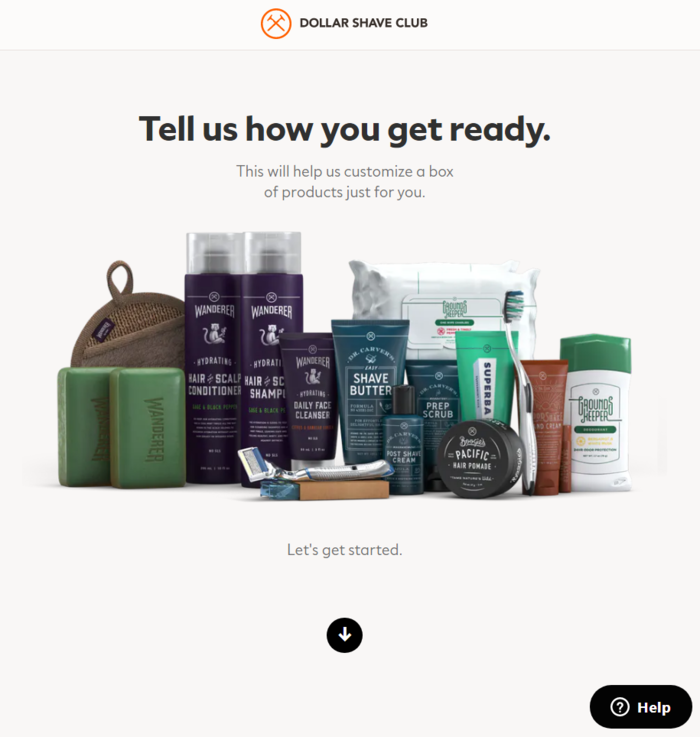
From there, you’ll complete a quiz and come out on the other end with a straightforward recommendation and a strong call-to-action. Of course, you can further customize your options by scrolling down the page.
On the surface, this might look like just another way to sell their products. In reality, that’s only half the story. Every aspect of this quiz is designed to ensure that consumers are presented with a solution that accurately addresses their pain points.
Lenovo, on the other hand, actually lets you build out your dream laptop.
It’s important to keep the limitations in mind, of course. While the laptop would be customized, the capacity of the laptop is limited.
When creating your customized product offerings, remember that removing concerns about compatibility can make life much simpler for your consumer. Unless they’re particularly tech-savvy, they probably wouldn’t understand why certain components just don’t work together.
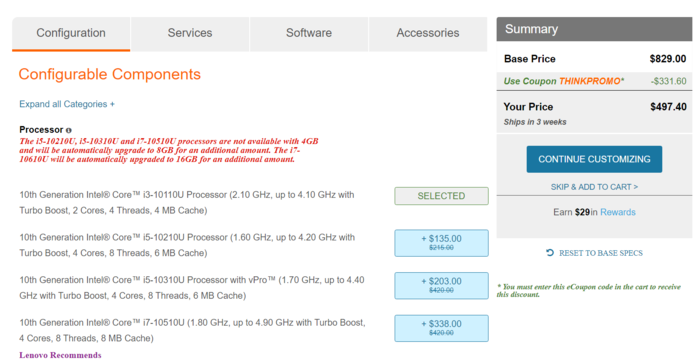
Alleviating friction before it becomes an issue is one of the many benefits that come from creating a rich customization experience.
Tips for Creating Customized Products
All of that looks and sounds great, but how on earth are you supposed to create customized products for your consumers? After all, offering 100+ options isn’t exactly budget-friendly.
Well, remember that consumers aren’t just interested in custom products. They want customized experiences. Most business owners already know this. It’s the reason so much time and money goes into marketing campaigns.
Focusing on customized experiences helps you develop a deeper relationship with your consumers. They can buy products anywhere, but your business is the only one that helps them customize their experience. Those better experiences lead to customer satisfaction, brand loyalty, and hopefully, repeat customers!
So, with that in mind, let’s take a look at some of the tools you can use to build tailor-made products and experiences.
Custom Fit
Whether you sell swimsuits, winter jackets, or everything in between, you understand that selling clothes online can be a customer satisfaction nightmare.
The biggest problem? Fit.
Everyone seems to have different definitions of small, medium, and large. While this can usually be fixed with a quick return and exchange, it tends to leave a bad taste in your customer’s mouth.
So rather than focusing on fixing the problem, let’s find a way to make sure it never happens again. Making it an engaging sales tool is just a bonus!
A Custom Fit quiz might seem simple but make no mistake: Making your customers feel more secure about their sizing choices means they’re more likely to purchase as possible sizing issues are avoided.
Customized Product Bundling
One of the most undervalued aspects of product customization is its potential for reducing friction.
When you offer to bundle an accessory with a particular product, you’re not just upselling to make some extra money on the sale. You’re addressing two possible customer pain points before they even arise.
Right off the bat, you’re making customers aware of the fact that a particular accessory is necessary to ensure they maximize their purchase. As a bonus, you’re able to confirm compatibility by clearly showing consumers which items they should pair together.
It’s a way to ensure that consumers walk away with everything they need after a single transaction. Further, it’s more than just a good sales tactic. It’s an effective, thorough customer satisfaction tactic.
Tips for Selling Customized Products
Maximizing your sales and profit margins is always going to be a priority, and every tactic here is designed to support that goal.
That being said, selling a consumer on the concept of customized products is less about actively selling and more about creating experiences that guide customers down the sales funnel with valuable information.
As far as I’m concerned, the best-customized experiences sell themselves. Of course, it helps if you’re building experiences that are so compelling and engaging that consumers can’t help but click the “Buy” button.
Use these tactics to drive conversions while still keeping the shopping experience engaging and personal.
Don’t Overcommit (Test the Waters)
All this talk of customized products might have you worried that you’ll need to spend tons of money on new inventory and be stocked up for potential buyers.
In reality, the process should start small. Unless you have a massive budget, your best bet is to test the waters and figure out what versions of products consumers are actively seeking.
If you’re experimenting with customizable T-shirt colors, you don’t need 50 new colors. Start with a few set colors, and give yourself plenty of lead time so you don’t have to rush production.
People aren’t interested in new colors? You can phase them out without worrying that you’ve let hundreds of dollars go to waste.
Customized Product Recommendations
We already discussed this a bit earlier, but the value of the customer quiz shouldn’t be understated.
Let’s say you frequently have website visitors that don’t have a well-defined shopping list yet. These are people who are just browsing and seeing what catches their eye.
Well, what if you could guide that person towards a sale, while also providing them with value in an engaging way? Sounds like a great way to kick-start your relationship, if you ask me. Keep in mind that 90% of consumers are willing to share their behavioral data if it’ll make their shopping easier.
By creating a simple quiz and offering customized product recommendations, you can accomplish so much.
For starters, customers will walk away with a much clearer understanding of their needs. They’ll also associate you with industry authority since your business showcased your know-how and expertise.
Beyond that, your consumers are one step closer to making a purchase through your site. All thanks to a simple, two-minute quiz.
Conclusion
Customized products are often seen as some sort of gimmick, a cheap way to offer variety instead of value.
Interestingly enough, I’ve found that well-designed customized products offer an impressive amount of value to consumers.
Consumers can be empowered by a process that simplifies their shopping experience. Or they can walk away with a deeper understanding of what they need from your business.
As long as your customized e-commerce experience is compelling, engaging, and generally value-driven, you can be optimistic that you’re enhancing your customer’s shopping experience and by extension, increasing your chances of making a sale.
What kind of customized products do you think offer the most value? Let me know in the comments below!
The post Why You Should Consider Selling Customized Products appeared first on Neil Patel.
How to Get Startup Funding

Building a business is thankless, difficult work. Sometimes, you just wish you had a little breathing room.
Usually, business owners have an idea of how they’d like to scale and grow their business. The only problem? Capital. There’s just not enough money to drive the growth they’d like to see.
It’s around this time that some businesses start to consider startup funding. Access to more capital means implementing better growth tools, expanding the team, and generally making the journey to profitability much smoother.
All of this sounds great, but it brings up important questions: How on earth are you supposed to get startup funding? What kind of funding should you consider? Does your business need startup funding?
I’m going to demystify the topic of startup funding and help you understand your options when it comes to raising money for your business.
How Do I Get Startup Funding for My Business?
Right off the bat, we need to establish a few ground rules.
It’s important that you understand what “raising money” actually does to your business. You’re essentially doing one of two things.
When it comes to startup funding, you’re either trading money for equity or trading it for debt.
When the average business owner pictures startup funding, they’re usually thinking about equity. To put it simply, equity is when you trade a percentage of your business in exchange for capital.
That equity is based on the perceived value of your company, which means it’s vital that you have some established value before you walk into an investor meeting. Ideas are great, but trust me when I say that these venture capitalists and angel investors have heard it all before. You’re going to need solid numbers and data if you want a chance at their money.
Of course, if you don’t have the data to secure startup funding from an investor, you could always rely on debt.
I’m just going to come out and say it: Going into debt as a startup is almost always the wrong approach. Whether it’s bank loans or credit cards, those terrible interest rates will eat your business alive. As “Shark Tank” investor Mark Cuban himself says,
If you’re starting a business and you take out a loan, you’re a moron. There are so many uncertainties involved with starting a business yet the one certainty that you’ll have to have is paying back your loan.
All of this is vital to understand because it highlights the reality of startup funding. What you’re really doing is giving pieces of your business away in exchange for some cash. Think of it like you’re borrowing from your future self.
I bring this up because I’ve seen plenty of startups ask if they can raise money. Do you know what I don’t see? Startups asking if they even need to raise money.
Don’t get me wrong, if your startup ends up being as big as Facebook or Slack, you can probably afford to trade some equity to increase cash. But trading away pieces of your profits just to keep your business afloat won’t be the right path for everyone.
Before you continue down this path, you and your team need to sit down and establish your needs, as well as the potential risks and rewards associated with each form of startup funding.
Remember, every single startup is going to have different needs, different risk tolerances, and different definitions of success. Consider each of these startup funding options carefully and make informed decisions for your business. Your future self will thank you.
How Much Startup Funding Do I Need?
Before you start asking for investor money, it’s essential that you establish your startup costs and how much you’ll need to continue building your business.
Assuming your business already exists, you should have a clear idea of your current expenses. As your startup continues to grow, it’s vital that you consider how much money your expansion is going to cost.
How much will you need for your new offices? How many employees will you be hiring, and what will their salaries be? What’s your projected ad spend? These are just some of the questions that you’ll need to have answers before you receive a dime from investors.
If you’re struggling, the SBA has a great startup costs calculator you can use to simplify this process.
When we think of startup funding, we tend to think of massive sums of money with startups raising millions of dollars. A study by Babson College found that the average business was able to start up with just $15,000 of funding.
When it comes to startup funding, it’s not about raising as much money as humanly possible. The goal is to raise the money you need without giving away too much of your startup in the process. Here are some options to do that, starting with the most common when we think of “startup funding.”
Check Out Startup Series Funding
The concept of Series funding can get rather complex, so for now, we’re going to address the basics.
This type of funding is typically thought of in terms of rounds. Series A round, Series B round, and so on.
But before any of that, there are a few other rounds that take place. Startups don’t usually just go straight into Series A, although it is possible.
First, there’s the pre-seed funding. This is friends, family, and other people in your support network. Seed stage funding is next, and this is typically where equity funding official starts. Venture capitalists and angel investors are usually found here, and these rounds will raise anywhere from $10,000 to $2 million.
Next, we have Series A funding. As the potential for greater funding increases, so does the level of scrutiny your business gets put under. Monetization is key here. These rounds typically run from $2 million to $15 million.
The rounds can continue from here, with each letter representing both an expectation of growth, as well as a potential increase in access to capital for your business.
Find Investors for Your Startup
Let’s assume that you didn’t make it to “Shark Tank.” How are you supposed to find investors?
There are typically five ways to find investors. The first, which I’ve already covered, is friends and family.
From there, you can look at loans and grants, but those aren’t realistic for every business. The more common option explored by startups is private investors. If you’re looking for angel investors, the Angel Capital Association is worth checking out.
While angel investors are typically individuals with a high net worth looking to invest, venture capitalists are using investor money to fund your business. It seems like a slight difference, but the approach to funding is actually very different.
Angel investors are interested in working with you to maximize the potential of the business. Venture capitalists are usually looking to fund a business that’s already well-established. Choosing the right investor can and will have a massive impact on the future development of your business.
Bootstrap Your Own Startup
Funding your startup through personal savings is far from glamorous, but it’s still your smartest move.
Why? The less of your company you have to give away, the better. But there’s something else at work when you’re bootstrapping your startup.
You’re creating tangible data that’s going to make raising money significantly easier.
Think about it. Most startups walk into investor meetings with a poorly designed MVP, a flimsy proof of concept, and a massive ask. More importantly, none of them address the elephant in the room.
Investors don’t care about good ideas. Investors want something tangible. They’re not looking to gamble away their money. They want the best possible chance of maximizing their returns.
Now, imagine you walk in with a fully formed business. Suddenly, the conversations are different. You don’t have an underwhelming MVP, you have a product that converts.
You don’t have a weak proof of concept, you’ve already established real product/market fit. As far as funding goes, you’re able to bring more to the table because your business is already off the ground.
When you bootstrap successfully, you’re able to present a much more compelling investment opportunity, while putting yourself in a strong negotiating position. This means better deals for you and peace of mind for investors, who know that your business is likely to be a winner.
Take the time to bootstrap your business, for as long as you can. It might not be as exciting as getting millions of dollars, but a bootstrapped business is 100% yours, and that’s pretty exciting to me.
Look for Business Startup Loans
While I don’t think that business startup loans are the right option for most founders, there is a right way to handle them.
Let’s start with what you need to know. A startup loan can be as low as $500 or as high as $750,000. The higher your loan, the more heavily your business plan will be scrutinized.
As a bare minimum, you should expect to explain both how and when you plan to make money. From there, you’ll likely be asked to explain why you’re better than your competition, how much potential your market has, etc. With some lenders, you’ll be required to present collateral, in the event that you can no longer pay back the loan.
Repayment of these loans can range anywhere from one to five years. You can expect to pay between 8% and 17%, even if your credit is solid. It’s worth mentioning that while you’re repaying this loan, it will be significantly harder for your business to secure another type of funding. After all, investors don’t want to be involved with a business that’s still paying their way out of debt.
Really, there’s only one reason you’d ever take out a startup loan. In a perfect world, you’re doing this because your business is already successful, you don’t want to give up equity, and you have a clear repayment plan that doesn’t create an excessive burden on your business.
Get Startup Funding From Family and Friends
This one is a bit tricky. On the surface, it sounds fantastic. It has the perks of a startup loan, without any of the drawbacks. Your friends and family can offer you capital for a low, or sometimes nonexistent interest rate. They’re also significantly more flexible when it comes to equity distribution, so what’s the problem?
Well, it’s family. Your support network might be rooting for you, but taking their money means they’re suddenly involved in the process. Suddenly, your decisions aren’t your own. Even when you own the majority of the company, family members might have their own ideas about how things should be done.
While there are plenty of entrepreneurs that raise money from friends and family, it’s a delicate decision to make. There are plenty of personal relationships that never recover after going into business together.
Still, it’s definitely an option to consider. Your wealthy aunt may not invite you to Thanksgiving this year if you lost all her money, but at least she won’t kick you out of your house.
Listen, if you have a rich uncle that was going to spend $25,000 on an addition to his house this year anyway, go ahead and see if he’s open to funding your business. Just understand that you’re not just dealing with your uncle anymore. You’re dealing with his money, too.
Raise Startup Money Through Crowdfunding
The average startup tends to ignore the possibility of crowdfunding for a few reasons.
Over the years, crowdfunding has developed a reputation as something of an incomplete funding strategy based more on wishful thinking than sound business sense.
Horror stories of products like the OUYA still haunt startup teams who are considering raising capital this way.
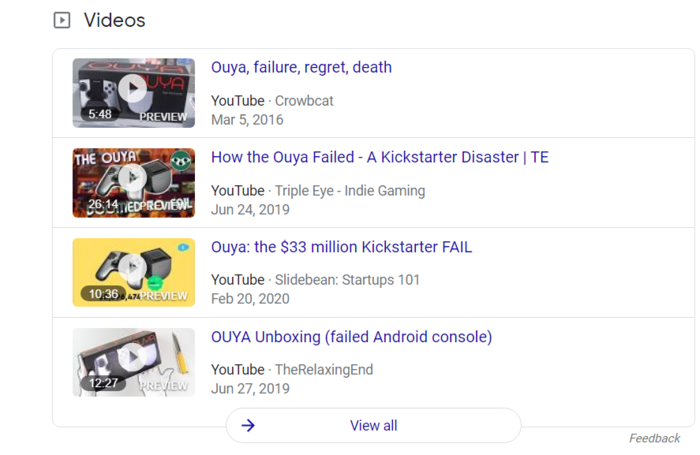
The second and more common reason is that they simply don’t know how to get started. It feels a bit more like putting on a performance than it does a round of investing.
The reality is that getting started is actually pretty straightforward. Start with a financial goal in mind. A common concept implemented within crowdfunding platforms is the concept of a stretch goal. The more money you raise, the more you’re able to deliver at launch.
Of course, you aren’t just getting money for free. Your new army of investors expects something valuable in exchange for their money. But with a bit of creativity and a strong understanding of what you can afford to offer financially, you should be able to make this work.
Once you have your goal and stretch goals established, start to build out the marketing materials. Make a video on who you are, and why they should invest in your business.
Crowdfunding is a highly competitive space, so don’t expect this to be easy. But if you’re willing to work for it, crowdfunding might just be the right approach for your business.
Apply for Small Business Grants
For whatever reason, small business grants aren’t looked into by most startup founders I talk to. I just figured they’d never heard of the concept, but now I’m starting to think it’s because they don’t think they’d qualify.
For example, the U.S. government is offering low-interest loans and even grants to small business leaders. Economically, the government supporting entrepreneurs makes financial sense. After all, competing internationally is much easier when your economy is boosted by five or six massively successful companies.
What does that mean for you? If you’re building a new tech or science business, you actually have a strong chance of securing some of that free government money. Plus, you typically qualify for state and federal grants.
Conclusion
Money being tight as an entrepreneur is nothing new. It’s natural to consider the option of startup funding. What’s important for you to keep in mind is that finding the right funding can make or break your business.
Take the time to consider your options carefully. If you can afford to bootstrap, do it for as long as you can. No matter what, protect yourself and your business so that it can develop properly over time.
Which kind of funding seems most interesting to you? Let me know in the comments below!
The post How to Get Startup Funding appeared first on Neil Patel.
How to Get Startup Funding

Building a business is thankless, difficult work. Sometimes, you just wish you had a little breathing room.
Usually, business owners have an idea of how they’d like to scale and grow their business. The only problem? Capital. There’s just not enough money to drive the growth they’d like to see.
It’s around this time that some businesses start to consider startup funding. Access to more capital means implementing better growth tools, expanding the team, and generally making the journey to profitability much smoother.
All of this sounds great, but it brings up important questions: How on earth are you supposed to get startup funding? What kind of funding should you consider? Does your business need startup funding?
I’m going to demystify the topic of startup funding and help you understand your options when it comes to raising money for your business.
How Do I Get Startup Funding for My Business?
Right off the bat, we need to establish a few ground rules.
It’s important that you understand what “raising money” actually does to your business. You’re essentially doing one of two things.
When it comes to startup funding, you’re either trading money for equity or trading it for debt.
When the average business owner pictures startup funding, they’re usually thinking about equity. To put it simply, equity is when you trade a percentage of your business in exchange for capital.
That equity is based on the perceived value of your company, which means it’s vital that you have some established value before you walk into an investor meeting. Ideas are great, but trust me when I say that these venture capitalists and angel investors have heard it all before. You’re going to need solid numbers and data if you want a chance at their money.
Of course, if you don’t have the data to secure startup funding from an investor, you could always rely on debt.
I’m just going to come out and say it: Going into debt as a startup is almost always the wrong approach. Whether it’s bank loans or credit cards, those terrible interest rates will eat your business alive. As “Shark Tank” investor Mark Cuban himself says,
If you’re starting a business and you take out a loan, you’re a moron. There are so many uncertainties involved with starting a business yet the one certainty that you’ll have to have is paying back your loan.
All of this is vital to understand because it highlights the reality of startup funding. What you’re really doing is giving pieces of your business away in exchange for some cash. Think of it like you’re borrowing from your future self.
I bring this up because I’ve seen plenty of startups ask if they can raise money. Do you know what I don’t see? Startups asking if they even need to raise money.
Don’t get me wrong, if your startup ends up being as big as Facebook or Slack, you can probably afford to trade some equity to increase cash. But trading away pieces of your profits just to keep your business afloat won’t be the right path for everyone.
Before you continue down this path, you and your team need to sit down and establish your needs, as well as the potential risks and rewards associated with each form of startup funding.
Remember, every single startup is going to have different needs, different risk tolerances, and different definitions of success. Consider each of these startup funding options carefully and make informed decisions for your business. Your future self will thank you.
How Much Startup Funding Do I Need?
Before you start asking for investor money, it’s essential that you establish your startup costs and how much you’ll need to continue building your business.
Assuming your business already exists, you should have a clear idea of your current expenses. As your startup continues to grow, it’s vital that you consider how much money your expansion is going to cost.
How much will you need for your new offices? How many employees will you be hiring, and what will their salaries be? What’s your projected ad spend? These are just some of the questions that you’ll need to have answers before you receive a dime from investors.
If you’re struggling, the SBA has a great startup costs calculator you can use to simplify this process.
When we think of startup funding, we tend to think of massive sums of money with startups raising millions of dollars. A study by Babson College found that the average business was able to start up with just $15,000 of funding.
When it comes to startup funding, it’s not about raising as much money as humanly possible. The goal is to raise the money you need without giving away too much of your startup in the process. Here are some options to do that, starting with the most common when we think of “startup funding.”
Check Out Startup Series Funding
The concept of Series funding can get rather complex, so for now, we’re going to address the basics.
This type of funding is typically thought of in terms of rounds. Series A round, Series B round, and so on.
But before any of that, there are a few other rounds that take place. Startups don’t usually just go straight into Series A, although it is possible.
First, there’s the pre-seed funding. This is friends, family, and other people in your support network. Seed stage funding is next, and this is typically where equity funding official starts. Venture capitalists and angel investors are usually found here, and these rounds will raise anywhere from $10,000 to $2 million.
Next, we have Series A funding. As the potential for greater funding increases, so does the level of scrutiny your business gets put under. Monetization is key here. These rounds typically run from $2 million to $15 million.
The rounds can continue from here, with each letter representing both an expectation of growth, as well as a potential increase in access to capital for your business.
Find Investors for Your Startup
Let’s assume that you didn’t make it to “Shark Tank.” How are you supposed to find investors?
There are typically five ways to find investors. The first, which I’ve already covered, is friends and family.
From there, you can look at loans and grants, but those aren’t realistic for every business. The more common option explored by startups is private investors. If you’re looking for angel investors, the Angel Capital Association is worth checking out.
While angel investors are typically individuals with a high net worth looking to invest, venture capitalists are using investor money to fund your business. It seems like a slight difference, but the approach to funding is actually very different.
Angel investors are interested in working with you to maximize the potential of the business. Venture capitalists are usually looking to fund a business that’s already well-established. Choosing the right investor can and will have a massive impact on the future development of your business.
Bootstrap Your Own Startup
Funding your startup through personal savings is far from glamorous, but it’s still your smartest move.
Why? The less of your company you have to give away, the better. But there’s something else at work when you’re bootstrapping your startup.
You’re creating tangible data that’s going to make raising money significantly easier.
Think about it. Most startups walk into investor meetings with a poorly designed MVP, a flimsy proof of concept, and a massive ask. More importantly, none of them address the elephant in the room.
Investors don’t care about good ideas. Investors want something tangible. They’re not looking to gamble away their money. They want the best possible chance of maximizing their returns.
Now, imagine you walk in with a fully formed business. Suddenly, the conversations are different. You don’t have an underwhelming MVP, you have a product that converts.
You don’t have a weak proof of concept, you’ve already established real product/market fit. As far as funding goes, you’re able to bring more to the table because your business is already off the ground.
When you bootstrap successfully, you’re able to present a much more compelling investment opportunity, while putting yourself in a strong negotiating position. This means better deals for you and peace of mind for investors, who know that your business is likely to be a winner.
Take the time to bootstrap your business, for as long as you can. It might not be as exciting as getting millions of dollars, but a bootstrapped business is 100% yours, and that’s pretty exciting to me.
Look for Business Startup Loans
While I don’t think that business startup loans are the right option for most founders, there is a right way to handle them.
Let’s start with what you need to know. A startup loan can be as low as $500 or as high as $750,000. The higher your loan, the more heavily your business plan will be scrutinized.
As a bare minimum, you should expect to explain both how and when you plan to make money. From there, you’ll likely be asked to explain why you’re better than your competition, how much potential your market has, etc. With some lenders, you’ll be required to present collateral, in the event that you can no longer pay back the loan.
Repayment of these loans can range anywhere from one to five years. You can expect to pay between 8% and 17%, even if your credit is solid. It’s worth mentioning that while you’re repaying this loan, it will be significantly harder for your business to secure another type of funding. After all, investors don’t want to be involved with a business that’s still paying their way out of debt.
Really, there’s only one reason you’d ever take out a startup loan. In a perfect world, you’re doing this because your business is already successful, you don’t want to give up equity, and you have a clear repayment plan that doesn’t create an excessive burden on your business.
Get Startup Funding From Family and Friends
This one is a bit tricky. On the surface, it sounds fantastic. It has the perks of a startup loan, without any of the drawbacks. Your friends and family can offer you capital for a low, or sometimes nonexistent interest rate. They’re also significantly more flexible when it comes to equity distribution, so what’s the problem?
Well, it’s family. Your support network might be rooting for you, but taking their money means they’re suddenly involved in the process. Suddenly, your decisions aren’t your own. Even when you own the majority of the company, family members might have their own ideas about how things should be done.
While there are plenty of entrepreneurs that raise money from friends and family, it’s a delicate decision to make. There are plenty of personal relationships that never recover after going into business together.
Still, it’s definitely an option to consider. Your wealthy aunt may not invite you to Thanksgiving this year if you lost all her money, but at least she won’t kick you out of your house.
Listen, if you have a rich uncle that was going to spend $25,000 on an addition to his house this year anyway, go ahead and see if he’s open to funding your business. Just understand that you’re not just dealing with your uncle anymore. You’re dealing with his money, too.
Raise Startup Money Through Crowdfunding
The average startup tends to ignore the possibility of crowdfunding for a few reasons.
Over the years, crowdfunding has developed a reputation as something of an incomplete funding strategy based more on wishful thinking than sound business sense.
Horror stories of products like the OUYA still haunt startup teams who are considering raising capital this way.

The second and more common reason is that they simply don’t know how to get started. It feels a bit more like putting on a performance than it does a round of investing.
The reality is that getting started is actually pretty straightforward. Start with a financial goal in mind. A common concept implemented within crowdfunding platforms is the concept of a stretch goal. The more money you raise, the more you’re able to deliver at launch.
Of course, you aren’t just getting money for free. Your new army of investors expects something valuable in exchange for their money. But with a bit of creativity and a strong understanding of what you can afford to offer financially, you should be able to make this work.
Once you have your goal and stretch goals established, start to build out the marketing materials. Make a video on who you are, and why they should invest in your business.
Crowdfunding is a highly competitive space, so don’t expect this to be easy. But if you’re willing to work for it, crowdfunding might just be the right approach for your business.
Apply for Small Business Grants
For whatever reason, small business grants aren’t looked into by most startup founders I talk to. I just figured they’d never heard of the concept, but now I’m starting to think it’s because they don’t think they’d qualify.
For example, the U.S. government is offering low-interest loans and even grants to small business leaders. Economically, the government supporting entrepreneurs makes financial sense. After all, competing internationally is much easier when your economy is boosted by five or six massively successful companies.
What does that mean for you? If you’re building a new tech or science business, you actually have a strong chance of securing some of that free government money. Plus, you typically qualify for state and federal grants.
Conclusion
Money being tight as an entrepreneur is nothing new. It’s natural to consider the option of startup funding. What’s important for you to keep in mind is that finding the right funding can make or break your business.
Take the time to consider your options carefully. If you can afford to bootstrap, do it for as long as you can. No matter what, protect yourself and your business so that it can develop properly over time.
Which kind of funding seems most interesting to you? Let me know in the comments below!
The post How to Get Startup Funding appeared first on Neil Patel.
Best Recruiting Software

Disclosure: This content is reader-supported, which means if you click on some of our links that we may earn a commission.
Are you a recruiter looking to streamline your hiring process? You’re hardly alone in that camp. Thankfully, there’s recruiting software that helps you do precisely that and then some.
In a fast-paced recruiting environment where you need to sift through hundreds of potential applicants with differing strengths and weaknesses, your best bet is adopting an applicant tracking software that allows you to make the best hiring decisions possible.
With so many recruiting software options to choose from, the problem is that it quickly becomes an overwhelming choice to make. No one wants to invest in tools that aren’t entirely useful to their process.
In this in-depth review, I’ll dive into the best recruiting software options on the market, as well as how to pick one that fits your business best without having to deal with the overwhelm.
Let’s get started.
The Top Recruiting Software Options For 2020
How to Choose The Best Recruiting Software For You
If you’re looking for an applicant tracking system (ATS), it’s clear your main goal is to make quality hires for your business in the most efficient way possible.
The question becomes, what criteria do you use to choose the best software-company fit? Here are a few key factors to consider:
Hiring Budget
Your business is unique, and so is the budget you assign to your hiring process.
With a bit of research, you can find an ATS that fits your company without putting you over budget.
If investing in a robust ATS software will save you money by making less bad hires in the long run, save you time by having instant access to large amounts of data, or let you employ less hiring managers, then the investment is well worth it.
In the ATS world, there is a range of prices you can choose from that help you stay on track financially. We’ll dive into more detail on that below.
Specific Features
Are you looking for a hiring system that lets you integrate email campaigns, pre-screenings, or specific candidate analytics?
Is testing a big part of your hiring process? Maybe you’re looking for a basic system that lets you compare applications with straightforward data.
Make a list of the features your business can’t compromise on, and use those as a filter for narrowing your best options.
Usually, additional features like landing pages, automations, planning software, or workflow integrations can be added down the road. This allows you to make the best choice for where your company is now and you can upgrade and build on it later.
Hiring Frequency
You might be a small company with a lower turnover rate. Or maybe you’re a sizable company with more than 500 employees and are constantly looking for new hires.
Your ATS needs to be able to handle the amount of hiring data you’ll be managing daily.
Ask yourself how frequently you make new hires and what your average turnover rate is. This will be a good way to filter which software will fit you best.
Recruiting Software Type
Are you a small up-and-coming business, a hiring agency, or a sizeable enterprise?
This is an important distinction to make when you’re choosing a system. No software system is a catch-all for every business. There are too many hiring variables and unique business needs for this to be the case.
While some software is built to handle hiring agency needs, others are better for an established business with in-house HR and hiring managers. Whether you need a simpler ATS or a more robust CRM is an additional distinction to make that we’ll talk about more in the following sections.
The Different Types of Recruiting Software
Recruiting software generally falls into three defining categories: applicant tracking software, candidate relationship management, and interviewing software. I break each of them down for you below.
Applicant Tracking Software
Processing job applications and resumes, keeping track of interviews, and managing job postings can all be done with a simple applicant tracking software.
These are basic capabilities most ATS software will have. As your company gets bigger, you’ll start looking for additional capabilities.
This is where we get into CRM software.
Candidate Relationship Management
If you need to gather a pool of potential candidates according to different hiring criteria on a rolling basis, then a candidate relationship management (CRM) system might be the better option for you.
An ATS focuses on managing applicants interested in any given active job ad, while CRM systems revolve around attracting the best talent from a candidate pool and managing it continuously.
This usually works best for enterprise-level businesses that are more established and are continually perusing and hiring through a pool of qualified candidates. It’s also an excellent option for hiring agencies.
Interviewing Software
Finally, interviewing software can be big time savers. Not only do they help you sift through potential candidates, but they allow you to schedule and record interviews and interview questions you can review on your own time.
This way, you can easily compare answers, as well as perceived candidate skills.
This is a great fit for larger companies with higher turnover rates.
Below, you’ll find a list of the best recruiting software for different criteria, along with pricing, features, and benefits.
#1 – Recooty – The Best Recruiting Software For Small Businesses

Recooty prides itself on being the easiest recruiting software for small businesses.
If yours is a small business, chances are you’re trying out hiring software for the first time. With Recooty, you can easily cover all your hiring basics.
You can post jobs, schedule interviews, check out possible resumes, and hire with a few simple clicks.
Though Recooty is geared towards smaller businesses, you can still create a branded careers page that fits your company profile. This, in particular, is a great feature that helps you differentiate yourself as a recruiter in the job market.
But you don’t have to stop there. You can also be accessible and post to the most popular job boards in no time.
Pros
- Bulk import and export when you’re ready to upgrade
- Branded careers page
- Ability to post to multiple job boards
- Social network sharing capabilities
Cons
- Very limited capabilities that don’t scale with the growth of your company
- Limited app integrations
- Does not offer CRM capabilities
Pricing
Recooty’s pricing is straightforward. You can choose to go with a monthly plan or save 20% with an annual payment.
For starters, Recooty has a great free plan that allows you to post three jobs, a branded career page, and lets you track applicants.
For more advanced options, you can choose the Pro Plan for $29 a month or the Ultra Plan for $49.
Check out each of their pricing tiers in detail here.
#2 – BambooHR – The Best Recruiting Software For Medium-Sized Businesses

BambooHR is a great solution for smaller to medium-sized businesses with more significant hiring needs. Their user interface is immensely easy to navigate and helps you get through the hiring and onboarding cycle seamlessly.
What makes BambooHR stand out is that they aren’t only an ATS but also a human resource system.
This means their all-in-one system also helps you track things like time off, payroll, employee timesheets, and report management once you’ve already hired a candidate. For a hiring team, this can be a real time-saver.
One of the more standout features of BambooHR is their expansive 45 app integrations with job sites like Indeed or Glassdoor to help you automate the job listing process.
Additional app integrations, like signing in through Google, connecting with Slack, or Universal Background Screening, make it that much easier to manage your prospect pool. Plus, if there isn’t an app integration you’d like to get, they give you the option of requesting one or using Zapier to make it happen.
Their best features make it easy to create and list job openings. They have an IOS and Android compatible app for easier access to hiring tools, data, and employee self-service features. This helps your hiring team create rapport and stay in constant communication with prospects and hires.
You can even add custom permissions at each stage of the hiring process for any company stakeholders wanting to give input on any candidate.
Pros
- Ability to create custom workflows from done-for-you templates
- Electronic signatures for easier paperwork management
- Applicant tracking for faster hiring
- User-friendly and easy to navigate
- HR reporting and analytics for optimal decision making
Cons
- Depending on your budget, some software capabilities will cost extra.
- If you choose the Essentials tier, you don’t get access to basic phone support.
Pricing
Though they list either an Essentials or Advantage option with the ability for add-ons, BambooHR doesn’t provide cookie-cutter pricing tiers.
Instead, they create personalized packages that work with your budget. You can either sign up for a free trial or receive a pricing quote on their website.
Get started with a free BambooHR trial here.
#3 – Bullhorn – The Best Recruiting Software For Recruiting Agencies

You might be wondering whether Bullhorn is an ATS or a CRM software. Well, it’s both.
If you’re a staffing agency with a hefty pool of applicants to manage, Bullhorn is your go-to system for streamlined and centralized hiring processes.
They make it easy to find and place talented hires in open roles at scale and without data storage limitations that might hold you back.
Their interface brings together the ability to manage the applicant and recruiting cycle so your team can make the best hiring decisions faster.
Integrations with Outlook, Gmail, and LinkedIn, also make it easier to communicate with potential hires, which is a key function for any recruiting agency. With Bullhorn, you can edit and parse any resume, add notes to applications, and even search keywords to find the right candidates for any open role.
One of their best features is the Bullhorn marketplace, with more than 100 applications to choose from.
This makes them a truly customizable platform that allows staffing agencies of any size to personalize their hiring processes and create a system that works for their team.
Pros
- Centralized talent sourcing system that helps your team collectively find the best hiring fit
- Advanced reporting to learn the health of your hiring system within a few clicks
- Highly customizable workflows
- Email tracking and mass emailing
- Detail-oriented resume parsing and keyword search
Cons
- It can be a pricey investment for up-and-coming recruiting agencies
Pricing
Bullhorn lists Team, Corporate, and Enterprise as their three main pricing tiers, but they don’t readily list their prices. You’ll have to request a pricing quote on their site since it’s based on the number of people on your team that need access to their system.
Request a Bullhorn pricing quote here.
#4 – Greenhouse – The Best Recruiting Software For Entreprises

Greenhouse is made for enterprises to manage hiring at scale. Structured hiring is the name of their game as they focus on creating an equitable interviewing and onboarding process for all candidates.
Their systems are designed to lessen problems like biased hiring by basing its decision-making on each applicant’s individual evidence and data. If you’re a big company focusing on hiring diversity, equality, fairness, and lessening bias, Greenhouse has built-in capabilities that help you nurture those values.
The Greenhouse interface is specifically designed to scale easily and grow right alongside your business with more than 300 hiring and management applications.
Their best recruiting tools include the ability to share application reviews, access to scorecards that evaluate candidates consistently, and even finer details like allowing candidates to pre-record the right pronunciation of their names for more inclusivity.
Pros
- Automated surveys to measure hiring experience
- Predictive analytics along with machine learning help make data-based decisions
- Onboarding performance measurement
- Accessible mobile apps for easy access to specs like candidate profiles, summaries, and scorecards
Cons
- Can be an expensive addition to your hiring process
Pricing
Greenhouse doesn’t list their prices since their pricing is based on the size of your organization.
You can get a custom quote by requesting their free demo here.
Conclusion
With the right recruiting software, you can forget the piles of paperwork and overbearing spreadsheets that are inefficient for getting you through the hiring process.
Adopting a system that caters to your specific business needs can make all the difference in the quality of your hires. Once you beat the overwhelm in the decision-making process, the next step is to make the choice and start.
Pick the best ATS software using this guide and start making better hires this week.
The post Best Recruiting Software appeared first on Neil Patel.
10 Useful Shopify Apps

By subscribing to Shopify’s e-commerce platform, Shopify customers can harness the platform’s shopping cart solution to sell, ship, and manage products. Founded in 2004, the e-commerce platform now reports an annual gross merchandise volume exceeding $61 billion and has over 500,00 merchants. While this number is massive, it also may be slightly daunting if you’re one in a half a million.
If you’re trying to make your service stand out among those other 500,000 merchants, Shopify offers thousands of apps that can help you optimize your commerce content. These Shopify apps range from email capture to photo optimization and everything in between.
If you’re looking to boost your success rate on the platform, there are many free ways to drive e-commerce traffic, but Shopify apps are definitely the first place you should look.
What Are Shopify Apps?
The Shopify App Store offers vendors thousands of apps. These Shopify apps function as plugins, extending a store’s functions and improving customer experience. Vendors can select a Shopify app to integrate with their store and be up and running with new functionality in no time at all.
Weeding through thousands of Shopify app options that promise optimized outcomes in all sorts of categories can be daunting, to say the least.
What Shopify Apps Should I Use?
To make the task of navigating the landscape of Shopify apps more manageable, we’ve chosen our overall “winners” in the realm of Shopify apps.
In no particular order, here are 10 useful Shopify apps:
Sumo
Sumo is a Shopify app that identifies as a “set-it-and-forget-it” tool.
Sumo allows you to implement proven marketing strategies on your site quickly and easily, resulting in reduced cart abandonment, increased average orders, and larger email lists.
What It’s Best For
The Sumo Shopify app is best for incentivizing customers.
Whether a customer is about to abandon their cart or depart from your virtual window, Sumo automatically creates targeted incentives to convert these browsers into shoppers. The app also provides data that lets you delve into customer interactions in your store.
Features of This Shopify App
This Shopify app allows you to incorporate simple, straightforward marketing techniques like cart reminders and exclusive offers. These strategies can help make your store successful.
Easy-to-use and easy-to-replicate in all campaigns, this Shopify app can help make your e-commerce dreams a reality.

Smile
Smile is a Shopify app and marketing tool that increases engagement to ensure you get more reviews on your products. This fun, effective plugin uses the power of emojis to help you increase engagement, build trust, and boost social response.
What It’s Best For
By providing a fun interface for your clients to leave feedback and reviews through emojis, the Smile Shopify app can help you build engagement, a metric that demonstrates to potential customers that your products are as good (if not better) than advertised.
Features of This Shopify App
The utility of this Shopify app makes it hard to beat. By using emojis as the preferred means of review, you eliminate the need for lengthy written responses. This makes it easier for your customers to share their experiences with your product, since all they have to do is click.
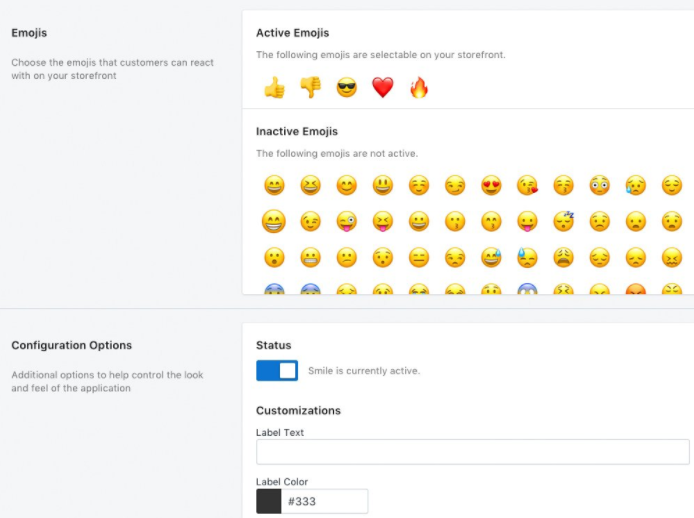
Judge.me
Judge.me is a Shopify app and engagement tool that helps you grow your online store by generating reviews via all modern marketing channels: Web, email, push, and SMS.
What It’s Best For
This Shopify app is best for generating reviews without begging for them. With Judge.me, users of the app select an email template and Judge.me does the rest: ask past and current customers for reviews automatically.
Features of This Shopify App
As big fans of automation, we love how easy this Shopify app is for generating reviews for your products. Plus, Judge.me’s cross-functionality allows you to take those reviews on the road and share them across your social channels, expanding exposure and reaching new audiences.
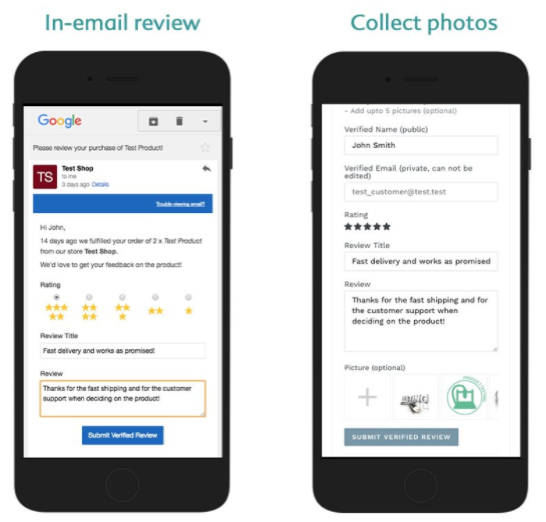
Printful
The Printful Shopify app advertises itself as your print-on-demand solution. By handling all of the custom printing needs for your store, Printful makes it easy to create unique items. Printful also satisfies your orders’ inventory, production, and shipping components, covering the logistics so you can focus on design and curation.
What It’s Best For
The Printful Shopify app is best for stores that sell custom printed goods. By streamlining the print-to-production-to-delivery process, this Shopify app makes a seller’s life infinitely easier.
Features of This Shopify App
We’re all for streamlined processes, which is why Printful landed on this list of Shopify apps.
By eliminating extraneous steps from the printing and distribution process, Printful supports your store in offering a wide array of custom printed items and eliminates the need for unnecessary trips to your preferred shipping locale.

Plug in SEO
The Plug In SEO Shopify app is an integration that continuously helps you optimize your content for SEO, among other traffic-driving features
Although it’s not better than manual SEO, this Shopify app helps you manage SEO optimization, and drive organic traffic to your shop, all through one simple plug-in.
What It’s Best For
This Shopify app isn’t just perfect for store owners who aren’t 100% comfortable handling their own SEO strategy—it’s for everyone. With help from this Shopify app, you can optimize and may rise in Google’s search results, making your business even more visible to potential customers using organic search.
Features of This Shopify App
The easy-to-use nature of this Shopify app also makes it a great choice for store owners wanting to increase their rank without spending a ton of time and effort digging into the nitty gritty of their rankings.
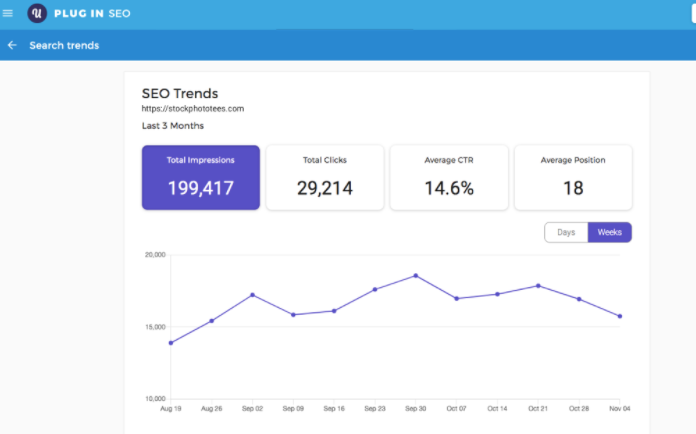
Sales Rocket
Sales Rocket is an all-in-one Shopify app that operates as a complete sales and marketing platform. The service boasts it can replace the forty apps you already have in rotation and goes the extra mile to streamline your store-related processes.
What It’s Best For
Sales Rocket was custom-made to increase your store load times and reduce spend on app charges, all while helping your store make money. By using features like scarcity and urgency timers, lead generators, and conversion boosters, Sales Rocket is designed to provide you with the power of many apps through a single platform.
Features of This Shopify App
With this Shopify app, you eliminate the need for extra apps that slow down your speed, resulting in decreased monthly costs.
Who doesn’t love to save money?
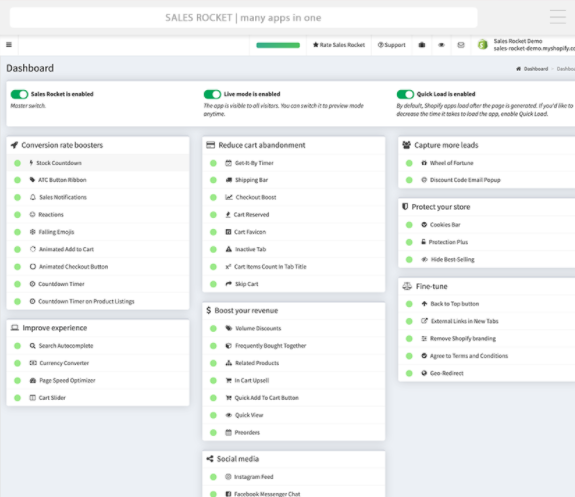
Kit
Kit is the virtual assistant you didn’t know you needed.
Created to make your life easier, this Shopify app will help you increase sales and build awareness through implementing marketing strategies.
What It’s Best For
Kit helps you build easy, effective Facebook and Instagram ads. The app even goes the extra step of posting the ads for you, making social advertising simple. Kit also offers email marketing automation, sending emails to clients and prospects alike.
Features of This Shopify App
This Shopify app truly feels like you have your own personal marketing assistant. Kit will message you about marketing opportunities, identify opportunities to make sales, and integrate with your other Shopify apps.
In short, Kit is the personal assistant we’ve all dreamed of, but never imagined existed.
SEO Site Audit
Site Audit provides a detailed site audit that gives you an unparalleled view of why your sales and conversions are not improving and why your site isn’t generating traffic. With this Shopify app, you can pinpoint problem areas and fix them with actionable steps from Site Audit.
What It’s Best For
This is the second SEO-facing Shopify app to make our list. While Plug In SEO helps you optimize existing content, SEO Site Audit does a deep dive of your entire site, giving you an unparalleled view of the inner-working of your site’s composition. (You can also use Ubersuggest for this.)
Features of this Shopify App
Data. Is. Awesome. Gaining a true understanding of what is and what is not performing well on your site will empower you to fix those issues, which will hopefully result in SEO success.
Vitals
Vitals is a Shopify app that is “vital” to your store’s success. With the functionality of 40 apps in one, Vitals helps you boost sales by increasing conversion rate and eliminating page speed issues.
What It’s Best For
This Shopify app is geared toward boosting every functionality of your site. From Facebook pixels to SEO, Vitals has solutions for all of your site-improvement needs
Features of This Shopify App
Vitals is the Swiss army knife of Shopify apps. By bundling so much functionality into one app, users get all the multi-app perks for less.
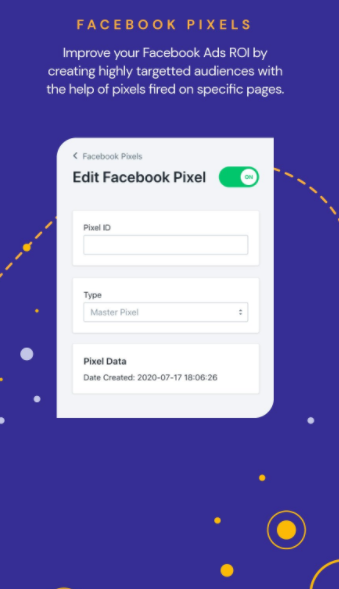
PushOwl
PushOwl is a Shopify app that helps your recover lost sales. Through an automatic sequence of push notifications, users are brought back to your cart.
This functionality eliminates the need to gather personal information, such as name or email address, making it that much easier to remind your customers of what they may have left behind.
What It’s Best For
This Shopify app is best for sellers without an abandoned cart recovery strategy. If this includes you, you definitely need to get PushOwl ASAP and start recovering abandoned carts.
With PushOwl, you can send push notifications via the browser and only require customers to use their browser. The push sequence is infinitely editable, allowing you to improve upon the original by altering timing, text, or incorporating a coupon.
Features of This Shopify App
We love this Shopify app for its ease-of-use. With PushOwl, there are no complicated forms to complete. It’s just a simple series of push notifications.

Conclusion
There are many strategies to make your Shopify store work, and Shopify apps are an excellent place to start.
The ten highlighted apps are just a sampling of those that exist in the Shopify App Store, so your options abound.
Regardless of your budget, by incorporating some, one, or all of these Shopify apps into your Shopify strategy, you can improve your understanding of the platform and hopefully convert a customer or two.
What is your favorite Shopify app available in the Shopify App Store?
The post 10 Useful Shopify Apps appeared first on Neil Patel.
How to Find Paid Social Media Keyword Ideas From Top Hashtags

In the world of digital marketing, content is king. And keywords hold the keys to that kingdom.
They unlock connections to your target market—people who are looking for what you’re trying to sell.
When you’re setting up paid social media campaigns, keywords can help you make those critical connections and ensure your campaign’s success.
Knowing which keywords to use throughout the copy of your campaign can be a pain. If you’re not sure which ones are right, you might miss the mark and, by extension, your audience.
Popular hashtags can be the source of inspiration that gets your paid social media campaigns off the ground.
The Importance of Hashtags in Paid Social Media Campaigns
Why are the top hashtags important for inspiration and keyword ideas? Because they can provide a lot of information if you know how to look for it.
Here are the questions you should ask when looking for hashtags:
- What are people talking about?
- What’s the demand for a particular product or service?
- Is there a rise in interest? Or is the trend on the decline?
- Who is using those hashtags?
- What’s the context of those conversations?
Researching popular hashtags can provide relevant insights into the conversations happening around a topic. Their power is in the data you can mine from real-life, real-time sources.
Top hashtags can also lead to other hashtags and keywords you may not have considered. As you continue to dig deeper, you may start to see some patterns to add to your campaigns.
Be on the lookout for:
- New or up-and-coming hashtags
- Hashtags used by other relevant target markets
- Questions or concerns people are expressing
- Phrases in the associated content that come up often
How to Use Trending Hashtags for Your Paid Social Media Campaigns
First, you have to find the top hashtags. Begin with what’s trending in your industry and go from there. We’ll go into more specifics on different social media platforms later.
As you dive in, explore the content surrounding the hashtags.
How do you use the information you found? It’s all about inspiration. The hashtags, phrases, and keywords you find can inform your paid social media campaigns in the following ways:
- For text: What you’ve learned can be a launching point for your ad’s language. Look at the posts’ content in addition to the hashtags, and incorporate the language people in your target market use. Knowing how people talk about things can teach you how to best speak to the pain points they face and the solutions they love.
- For images: What kinds of images are those hashtags often associated with? Whether you plan to use a stock image in your ad or create your own, let what you find attached to hashtags help determine the type of images you use. You may even find a meme that you can join in on, making your social media ad more engaging.
- For target audiences: Use the hashtag research to inform the parameters of your social ad reach. Who is using these hashtags? Where do they live? How old are they? What else are they interested in? These stats can help you narrow the ad reach to your target audience.
- For sponsored post research: In addition to helping your paid social ad content be more relevant, hashtags may also help pinpoint a recent post to put cash behind. Experiment with different top hashtags in your posts on each social platform you use. Those hashtags may help your posts perform well organically, and then you can choose to boost them with sponsorship.
Using Facebook Top Hashtags for Paid Ads
Let’s start with Facebook, one of the most popular platforms for online marketing.
With over two billion users per month, there’s got to be some great data out there for your hashtag research.
You are probably only connected with a tiny number of those people, but don’t let that stop you. In fact, you can choose who sees your Facebook ads:
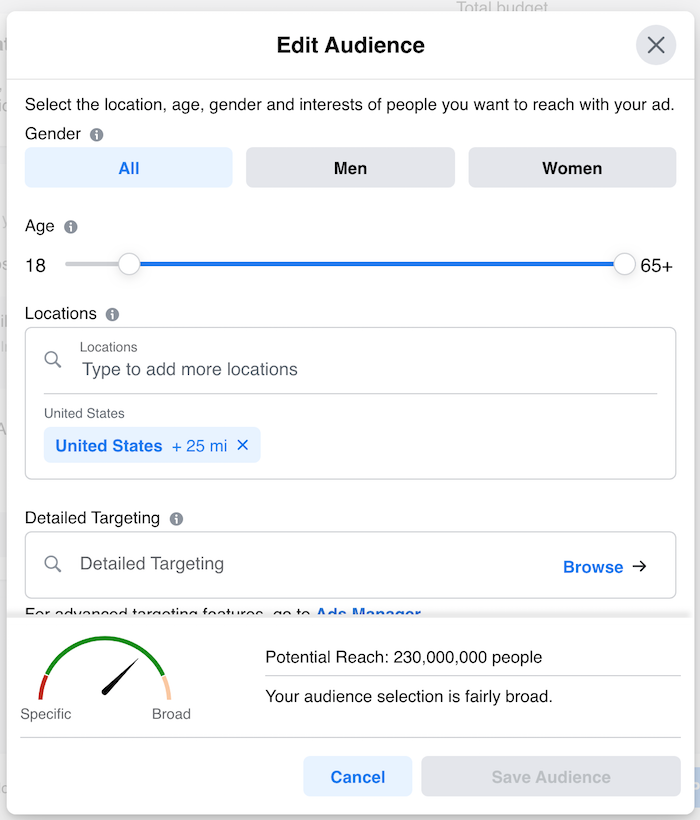
But, before you create the ad, you need to find the right words to use that are getting the most visibility. This is where hashtags come into play.
A quick search for #tacos on Facebook shows some drool-worthy meals from strangers around the world who made their posts public as well as from brand pages. You do this from your search bar.
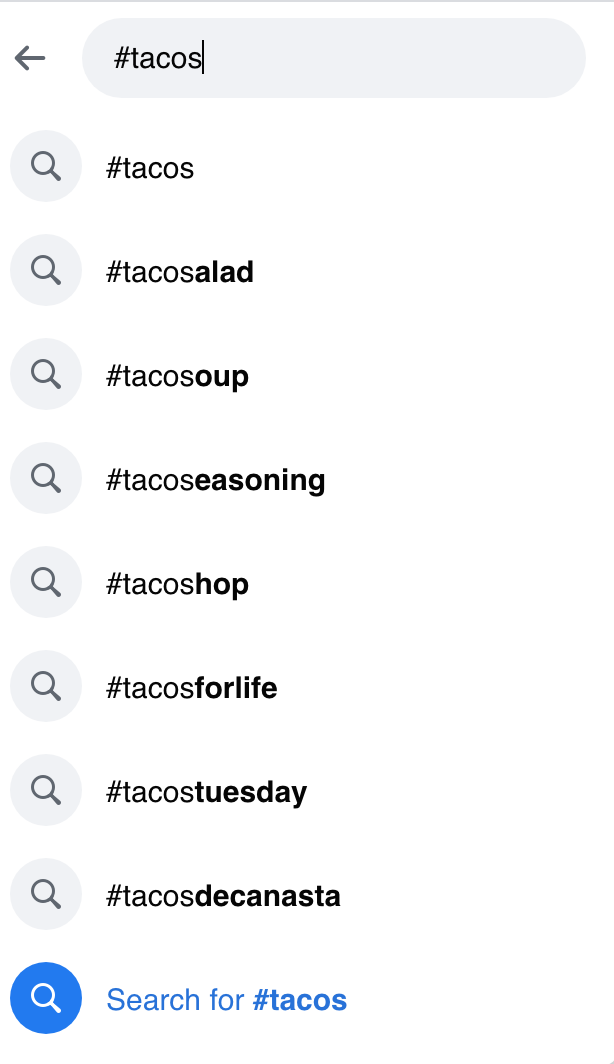
That list shows you what words most commonly follow that hashtag. Additionally, when you submit the hashtag you’re searching for, Facebook shows you on the top of the next page how many people are talking about that topic:

When you type in the hashtag that interests you, Facebook also auto-fills other hashtag options to explore.
You can also explore the bookmarks that Facebook makes available, including local events, crisis response, or other timely topics. These can provide insights into why people are using this hashtag.
Using Instagram Top Hashtags for Paid Ads
Instagram is a hashtag-heavy environment, making it ideal for top hashtag research.
Much like on Facebook, you can start by typing your hashtag ideas into the search bar. Instagram not only auto-fills suggestions but also shows you how popular those hashtags are based on how many posts include them.
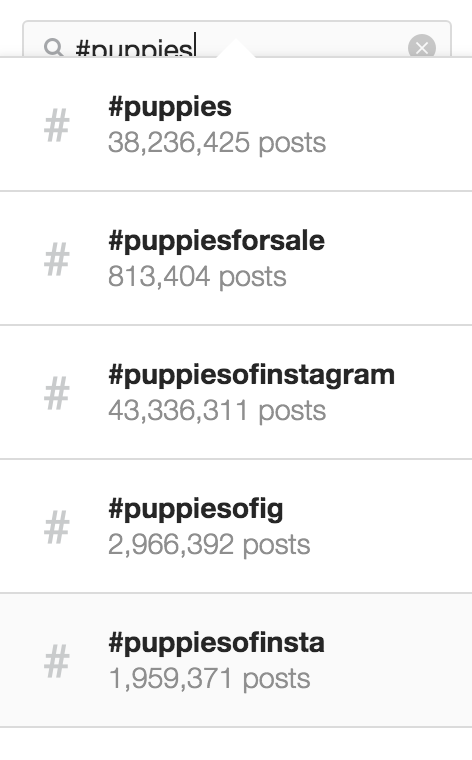
Instagram Explore
Are you still looking for more hashtags to dig into? Head to Instagram’s “Explore” section, with the compass icon, to see top posts related to content you have interacted with in the past. You may discover new or emerging hashtags that you didn’t know about.

Now is an excellent time to stop and talk about how hashtags don’t always translate directly into keywords and phrases for paid social media campaigns. You may have to convert from a succinct hashtag to a robust, natural way of talking. Here are a few tips for doing that:
- Listen to What Influencers are Saying With Those Hashtags: Take some time to watch the video posts and Instagram stories associated with the hashtags you’re researching. Hear how they talk about the subject. What are some key phrases that come up often?
- Read and Take Some Notes About What the Hashtags are Saying: Now it’s time to turn off the videos and read the actual content. What are they using those character counts to say? This is where you can learn about key phrases that everyone is using and the meat behind the hashtag topics you are researching. For instance, a top hashtag may be “#cleanbeauty,” but it’s not about skin cleanliness—it’s about toxicity in beauty products, congressional oversight, regulations in the industry, and how to know what’s safe for your family’s skin. Learning about the issues and conversations behind the topics can help you frame paid social media content in a usable way.
- Talk Out Loud Using the Instagram Hashtags: Hopefully, you’re working by yourself because this could get a little awkward: It’s time to start talking to yourself. Go ahead. As you’re writing down ideas that we talked about earlier and starting to craft your social media ad content, actually saying it out loud may help disconnect you from “internet speak” and get you into using a more natural tone.
Using Twitter Top Hashtags for Paid Ads
If you’re using Twitter on your mobile device, you can hit the magnifying glass icon at the bottom of your screen to see what’s trending. If you’re on your desktop, hit “#Explore” on the left side of the screen, then click “Trending” to see currently popular hashtags.
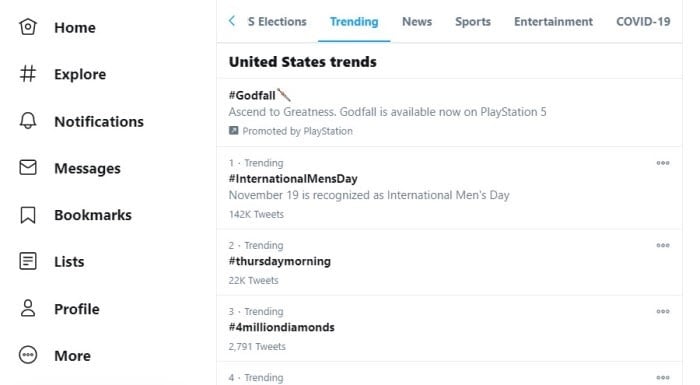
You can see what topics Twitter thinks are important now based on their editorial board and algorithms, as well as how many tweets are using those hashtags. Keep in mind some of these are promoted hashtags, not organic ones, though—they are labeled, as you can see with “#Godfall” at the top of this screenshot.
To learn more, click on “Show More” or the “Explore” section on the desktop layout to see more about these topics and find more currently in use.
You may need to dig deep to find hashtags that are relevant to your niche. When you see a conversation or post around topics pertinent to your industry, check out those hashtags.
Don’t be afraid to see a spark of inspiration, such as a new hashtag that’s just starting to catch fire, and get onboard that topic before it becomes a wildfire.
Using LinkedIn Top Hashtags for Paid Ads
Where do you go to find the top hashtags on LinkedIn? There are a couple of different ways to start your research.
You can look up hashtags in the search bar at the top, just as you do on other social media platforms:
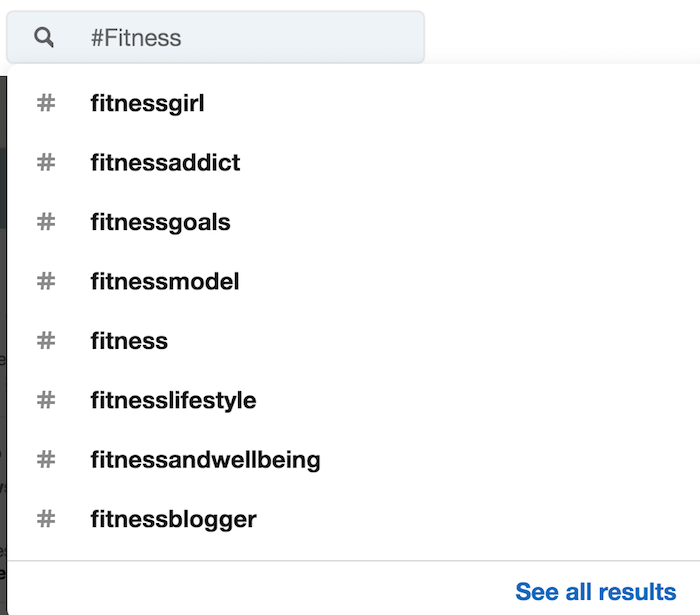
And like other platforms, LinkedIn will auto-recommend other options.
When you choose a hashtag, LinkedIn shows how many people are currently following that hashtag. This data can help you understand how many people may see your posts that incorporate that hashtag. You will also see top posts with that hashtag.
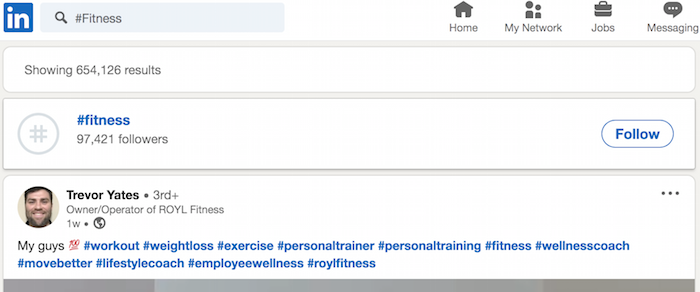
When you follow a hashtag you’re interested in, you can click on the three dots on the right of your followed hashtags and choose “Discover new hashtags.”
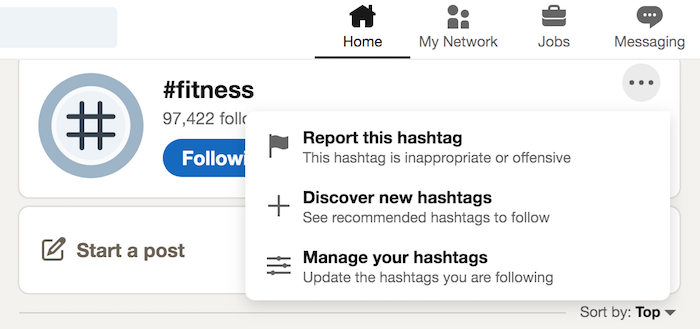
Now you’ll see all kinds of popular hashtags to inspire you.

If you want to skip those steps and just start exploring, you can go straight to LinkedIn’s Follow Fresh Perspectives tab to see the top hashtags, accounts, and companies LinkedIn recommends to you.
Context Is Key When it Comes to Using LinkedIn
Here’s the critical thing to remember about LinkedIn: It’s a popular platform for content, but it’s also very specific in its contextual use. LinkedIn is generally about professional or career conversations.
Using Pinterest Top Hashtags for Paid Ads
Are you trying to reach a creative, DIY crowd with your paid social media ads? Pinterest can show you what’s hot right now.
With Pinterest, hashtags aren’t as critical and promoted as they are on other platforms. Keywords in a post seem to be just as crucial for searching.
Here is a search for the popular term “Hygge:”
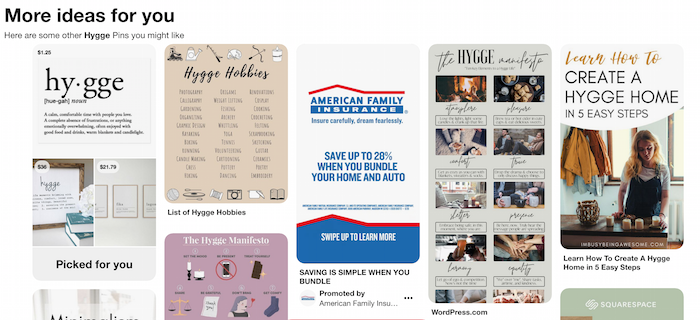
And a search for “#Hygge:”

You’ll notice similar results. So, just searching around for popular topics on Pinterest and exploring the top posts may prove just as useful.
However, if you are looking for top hashtags, there is a workaround. You can log in to the mobile app, click to create a new pin, and type a hashtag into the description section. This will give you a listing of top alternatives and stats for how popular they are.

More Tools For Finding Hashtags
If you’re still looking for the right hashtag, you may want to try one of the many hashtag search tools. These online and app tools allow you to plug in hashtags you’re using, and find related and popular hashtags. A few options include:
- Hashtagify
- All Hashtag Generator
- #HashMe app for Apple devices
- Hashtag Expert app
- Ritetag app or Chrome extension
Conclusion
The key to using hashtags for paid social media is to use them as a launching point. They should inspire relevant content for your very specific target market. Hashtags can help you understand who they are, what they care about, and how they talk online.
Popular hashtags can also open the door to new opportunities for your social media strategy as you join fresh, ongoing conversations happening online and reach out to new markets.
Which popular hashtags will you be analyzing to inform your next social media ad campaign?
.
The post How to Find Paid Social Media Keyword Ideas From Top Hashtags appeared first on Neil Patel.

